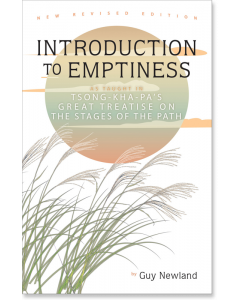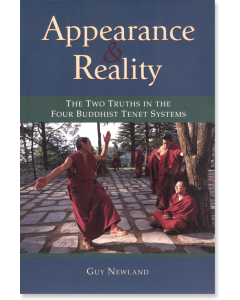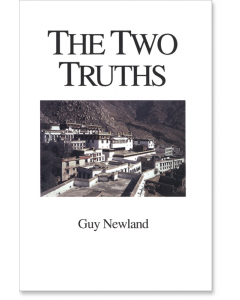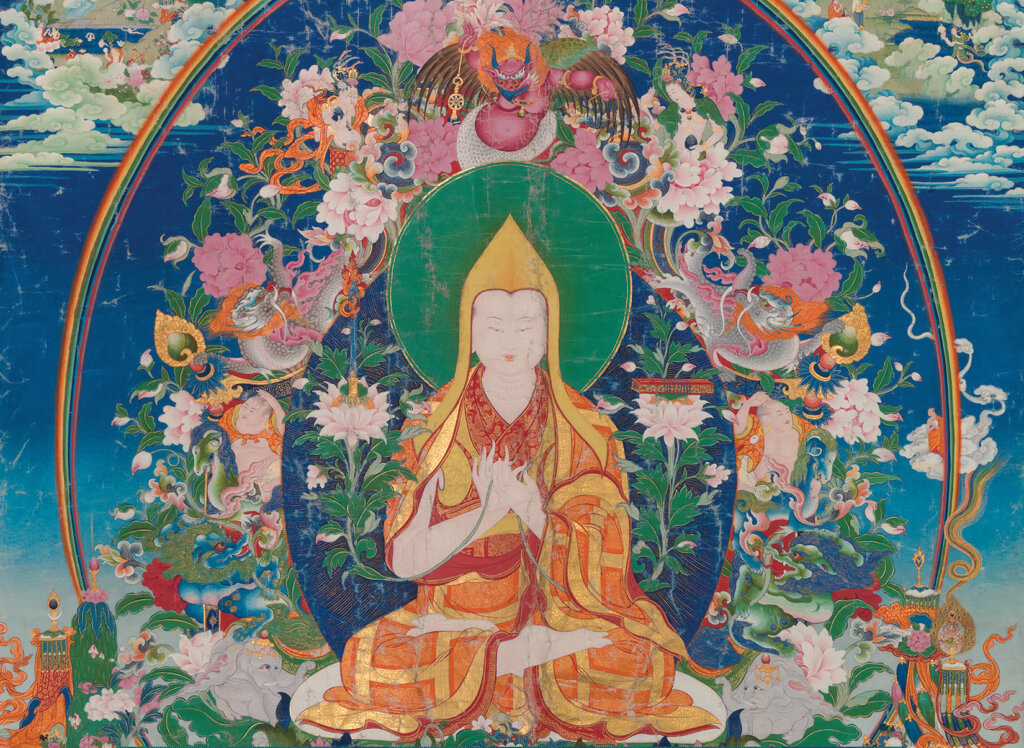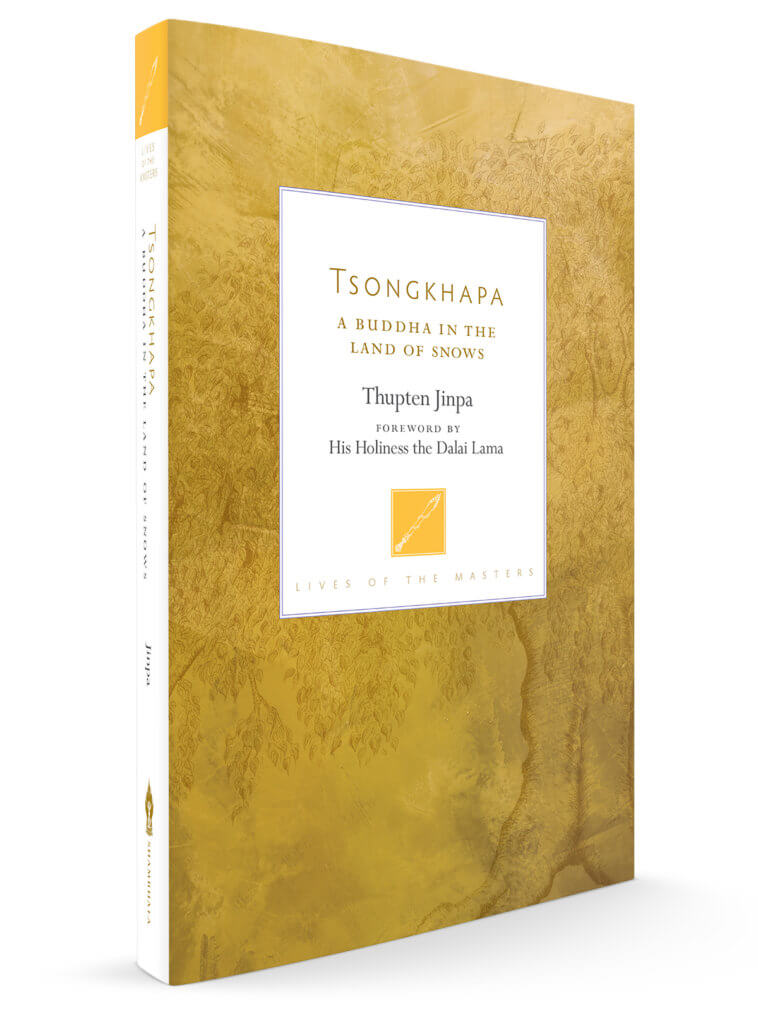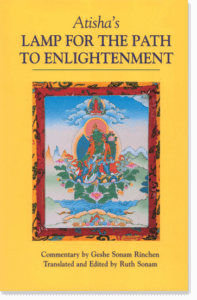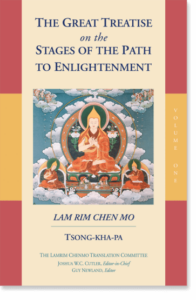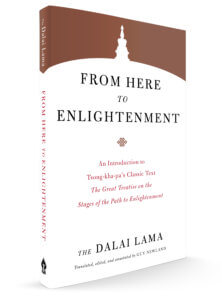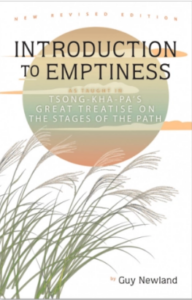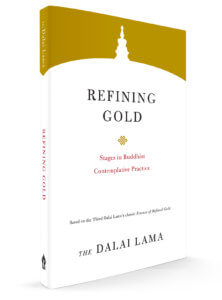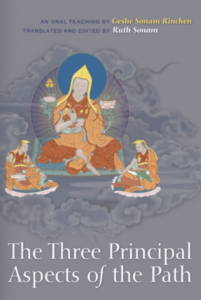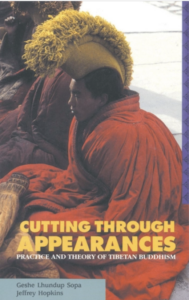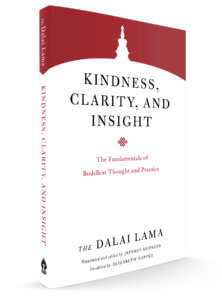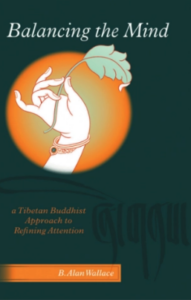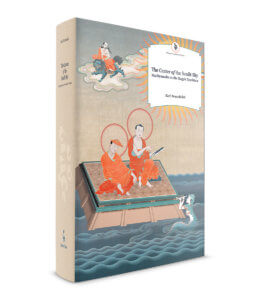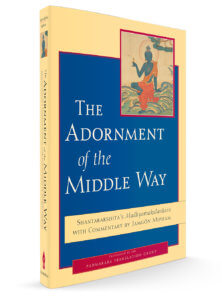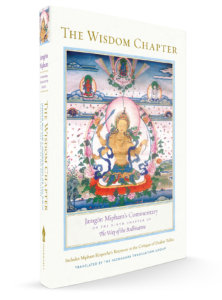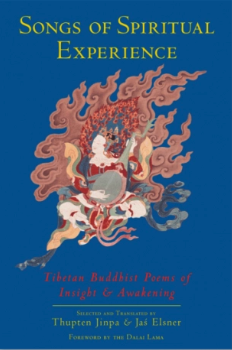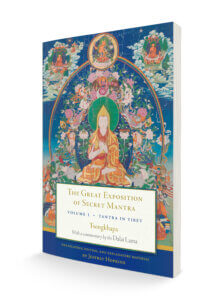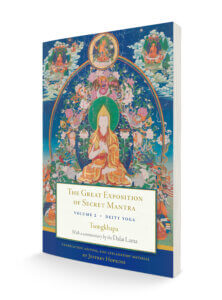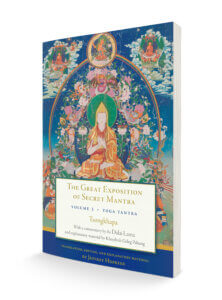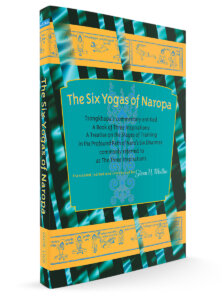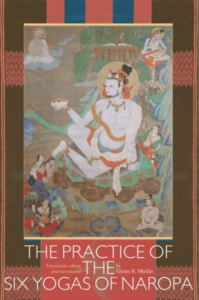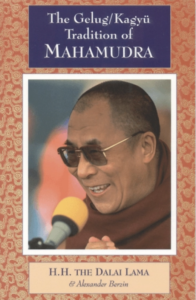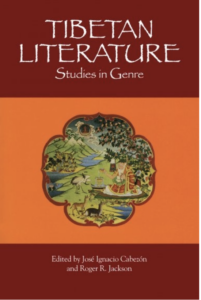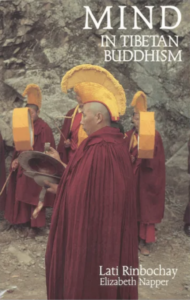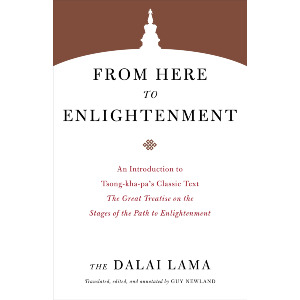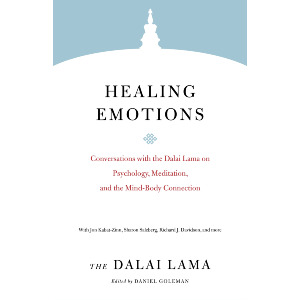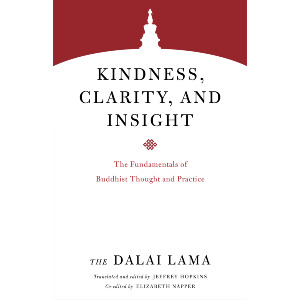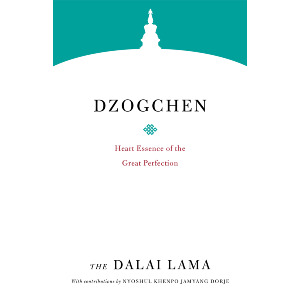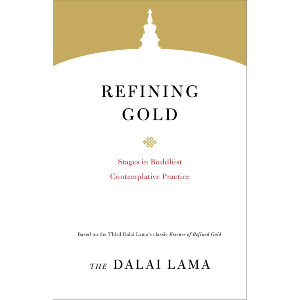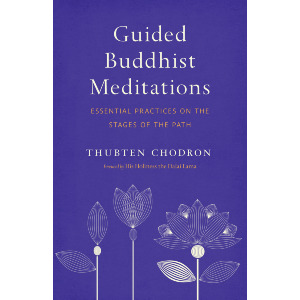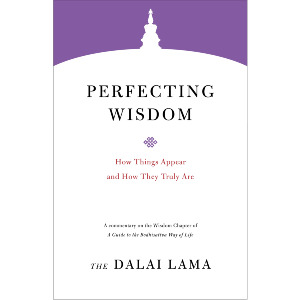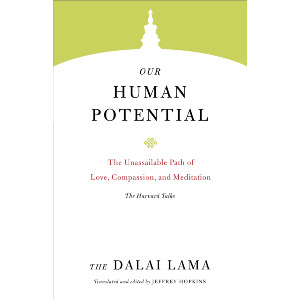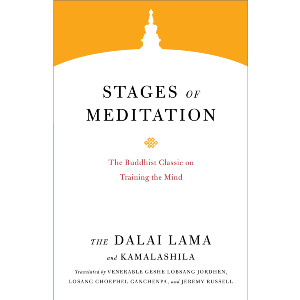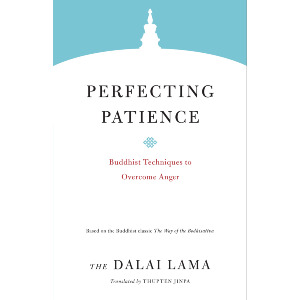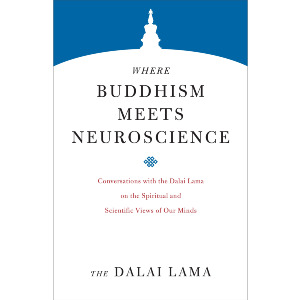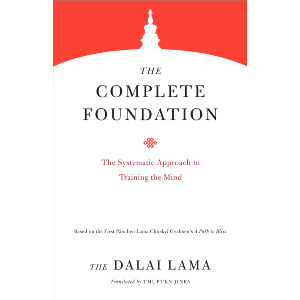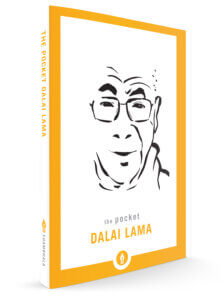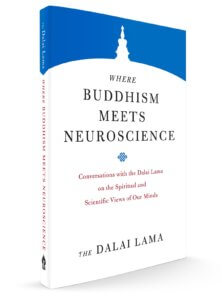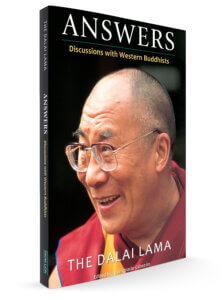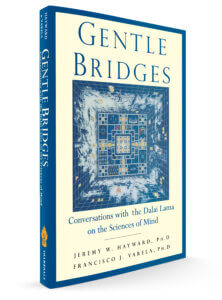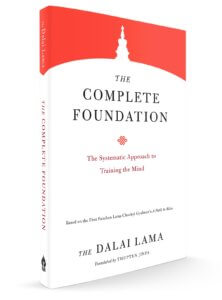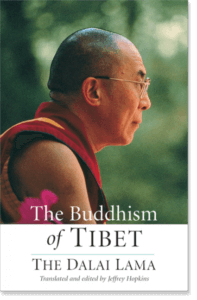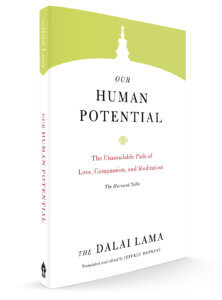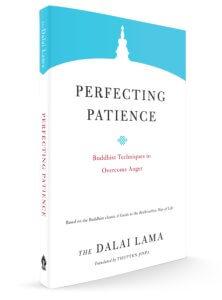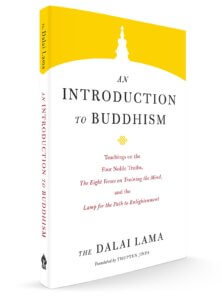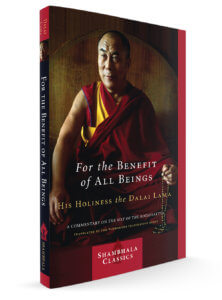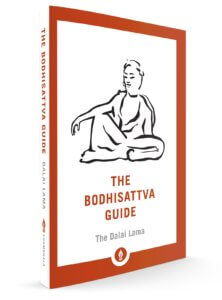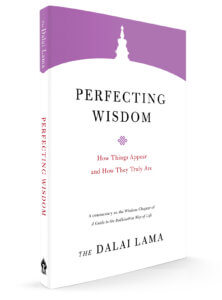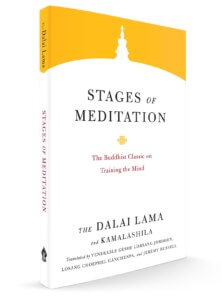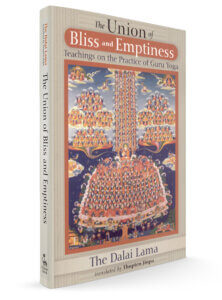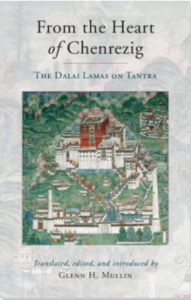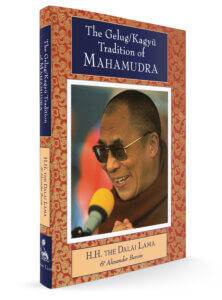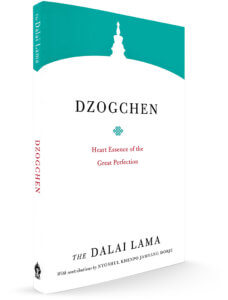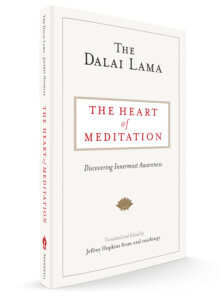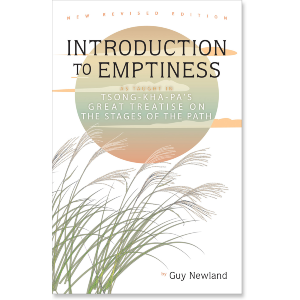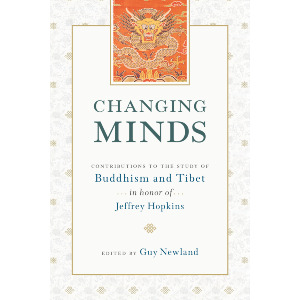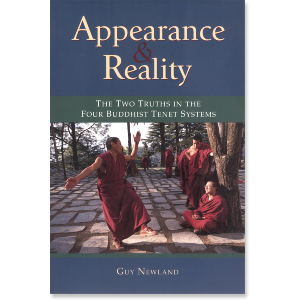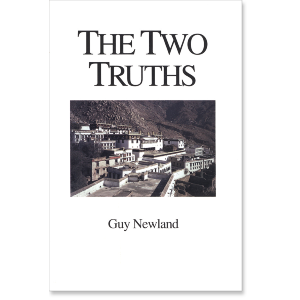

Guy Newland
Guy Newland is Professor of Religion and Chair of the Department of Philosophy and Religion at Central Michigan University, where he has taught since 1988. He has authored, edited, and translated several books on Tibetan Buddhism, including the three-volume translation of The Great Treatise on the Stages of the Path to Enlightenment.
Guy Newland
Guy Newland is Professor of Religion and Chair of the Department of Philosophy and Religion at Central Michigan University, where he has taught since 1988. He has authored, edited, and translated several books on Tibetan Buddhism, including the three-volume translation of The Great Treatise on the Stages of the Path to Enlightenment.
-
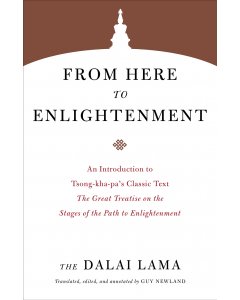 From Here to Enlightenment$19.95- Paperback
From Here to Enlightenment$19.95- PaperbackBy H.H. the Fourteenth Dalai Lama
Translated by Guy Newland -
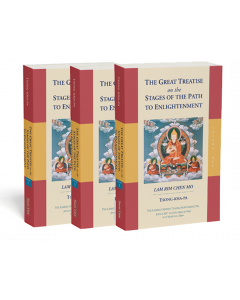 The Great Treatise on the Stages of the Path to Enlightenment Collection
The Great Treatise on the Stages of the Path to Enlightenment CollectionStarting at $28.95
By Tsongkhapa
- Buddhist Academic 2item
- Buddhist Anthology 1 item
- Buddhist Overviews 2item
- Buddhist Philosophy 4item
- Dependent Origination 2item
- Introductions to Buddhism 1 item
- Bon Tradition 1 item
- Dalai Lamas 1 item
- Dzogchen 1 item
- Gelug Tradition 6item
- Lam Rim 2item
- Madhyamaka 2item
- Mahamudra 1 item
- Shamatha 1 item
- Stages of Meditation 1 item
- Vipassana/Lhatong (Tibetan Specific) 1 item
GUIDES
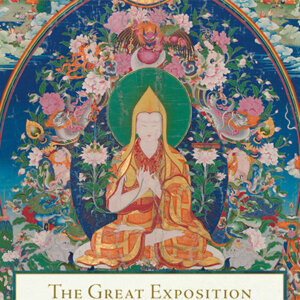
Tsongkhapa: A Guide to His Life and Works

The Life of Tsongkhapa Lobsang Drakpa (1357-1419)
Tsongkhapa Lobzang Drakpa (1357–1419), was one of the most important figures in Tibet, historically and philosophically. As the founder of the Gelug school he made an enormous contribution to revitalizing Buddhism in Tibet. Regarded as an emanation of Manjushri--the bodhisattva of wisdom and discerning intelligence, Tsongkhapa was of keen intellect as well as experiential understanding of the Buddhist tradition. He undertook many long retreats during which he had profound visions out of which he wrote many of his celebrated treatises including Lam Rim Chenmo or The Great Exposition of the Stages of the Path. A prolific writer, he composed 210 treatises, compiled into 20 volumes wherein he emphasized the combined paths of Sutra and Tanta. In addition, he established the acclaimed Ganden monastery.
For a longer biography of Tsongkhapa read an excerpt from Geshe Sonam Rinchen's commentary on The Three Principal Aspects of the Path.
"Born in 1357 in Amdo, northeastern Tibet, and educated in central Tibet, Tsongkhapa led a life that exemplified the importance of study, critical reflection, and meditative practice. In an autobiographical poem he declared:
"First I sought wide and extensive learning,
Second I perceived all teachings as personal instructions,
Finally, I engaged in meditative practice day and night;
All these I dedicated to the flourishing of the Buddha’s teaching.By the end of his life, 600 years ago, Tsongkhapa was widely revered across Tibet. He had studied and corresponded with the most renowned teachers of his time, from all the major traditions, and had spent years in meditative retreat."
—From the Foreward by H. H. The Dalai Lama, Tsongkhapa: A Buddha in the Land of Snows, by Thupten Jinpa
The Definitive Biography of Tsongkhapa
Paperback | Ebook
$29.95 - Paperback
Marking the 600th anniversary of Tsongkhapa, in 2019 we published what is the most comprehensive, definitive biography of this great figure, written by Thupten Jinpa. The author is best known as the main translator for the Dalai Lama, but he is an author and scholar himself, having earned a Geshe degree. In the author’s words,
this new biography of Tsongkhapa…is aimed primarily at the contemporary reader. And it seeks to answer the following key questions for them: ‘Who was or is Tsongkhapa? What is he to Tibetan Buddhism? How did he come to assume the deified status he continues to enjoy for the dominant Geluk School of Tibetan Buddhism? What relevance, if any, do Tsongkhapa’s thought and legacy have for our contemporary thought and culture?
—Thupten Jinpa, from the Introduction to Tsongkhapa: A Buddha in the Land of Snows
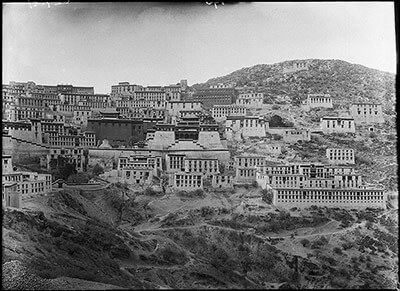
Ganden monastery, founded by Tsongkhapa, photographed in 1921 by Sir Charles Bell
Whoever sees or hears
Or contemplates these prayers,
May they never be discouraged
In seeking the bodhisattva’s amazing aspirations.
By praying with such expansive thought
Created from the power of pure intention,
May I achieve the perfection of prayers
And fulfill the wishes of all sentient beings.
Tsongkhapa's Lam Rim Chenmo, The Great Treatise on the Stages of the Path to Enlightenment
Tsongkhapa's main contribution to this genre is the famous Lamrim Chenmo or The Great Treatise on the Stages of the Path to Enlightenment. It is also generally considered his most influential work, studied and practiced by tens of thousands today.
The background to this work is on one of Tsongkhapa’s own letters to a lama, included in Art Engle's The Inner Science of Buddhist Practice, where he describes it as building on Atisha’s Lamp for the Path to Enlightenment:
“It is clear that this instruction [introduced] by [Atisha] Dīpaṃkara Śrījnāna on the stages of the path to enlightenment . . . teaches [the meanings contained in] all the canonical scriptures, their commentaries, and related instruction by combining them into a single graded path. One can see that when taught by a capable teacher and put into practice by able listeners it brings order, not just to some minor instruction, but to the entire [body of] canonical scriptures. Therefore, I have not taught a wide variety of [other] instructions.”
Paperback | Ebook
$19.95 - Paperback
The Great Treatise on the Stages of the Path to Enlightenment (Vol. 1-3)
The Great Treatise on the Stages of the Path to Enlightenment (Tib. Lam rim chen mo) is one of the brightest jewels in the world’s treasury of sacred literature. The author, Tsong-kha-pa, completed it in 1402, and it soon became one of the most renowned works of spiritual practice and philosophy in the world of Tibetan Buddhism. Because it condenses all the exoteric sūtra scriptures into a meditation manual that is easy to understand, scholars and practitioners rely on its authoritative presentation as a gateway that leads to a full understanding of the Buddha’s teachings.
Tsong-kha-pa took great pains to base his insights on classical Indian Buddhist literature, illustrating his points with classical citations as well as with sayings of the masters of the earlier Kadampa tradition. In this way the text demonstrates clearly how Tibetan Buddhism carefully preserved and developed the Indian Buddhist traditions.
Paperback| Ebook
$34.95 - Paperback
(Volume 1)
By Tsongkhapa
Edited by Joshua Cutler and Guy Newland, Translated by Lamrim Chenmo Translation Committee
This first of three volumes covers all the practices that are prerequisite for developing the spirit of enlightenment (bodhicitta).
Paperback| Ebook
$28.95 - Paperback
(Volume 2)
By Tsongkhapa
Edited by Joshua Cutler and Guy Newland, Translated by Lamrim Chenmo Translation Committee
This second of three volumes covers the deeds of the bodhisattvas, as well as how to train in the six perfections.
Paperback| Ebook
$34.95 - Paperback
(Volume 3)
By Tsongkhapa
Edited by Joshua Cutler and Guy Newland, Translated by Lamrim Chenmo Translation Committee
This third and final volume contains a presentation of the two most important topics in the work: meditative serenity (śamatha) and supramundane insight into the nature of reality (vipaśyanā).
Commentaries on Tsongkhapa's Great Treatise and other Lam Rim (Stages of the Path) texts
"The Great Treatise was written by Lama Tsong-kha-pa, a great scholar, a real holder of the Nalanda tradition. I think he is one of the very best Tibetan scholars. Although it is now widely available in Tibetan as well as English, you see that I brought with me today my own personal copy of this text. On March 17th, 1959, when I left Norbulingka that night, I brought this book with me. Since then I have used it ten or fifteen times to give teachings, all from this copy. So this is something very dear to me."
-H.H The Dalai Lama discussing his copy of the Great Treatise in From Here to Enlightenment
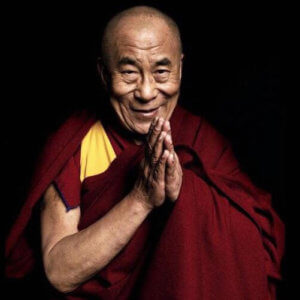
Paperback | Ebook
$19.95 - Paperback
From Here to Enlightenment
An Introduction to Tsong-kha-pa's Classic Text The Great Treatise on the Stages of the Path to Enlightenment
By H.H. The Dalai Lama and translated by Guy Newland
When the Dalai Lama was forced into exile in 1959, he could take only a few items with him. Among these cherished belongings was his copy of Tsong-kha-pa’s classic text The Great Treatise on the Stages of the Path to Enlightenment. This text distills all the essential points of Tibetan Buddhism, clearly unfolding the entire Buddhist path.
In 2008, celebrating the long-awaited completion of the English translation of the Great Treatise, the Dalai Lama gave a historic six-day teaching at Lehigh University to explain the meaning of the text and underscore its importance. It is the longest teaching he has ever given to Westerners on just one text—and the most comprehensive. From Here to Enlightenment makes the teachings from this momentous event available for a wider audience.
Paperback | Ebook
$21.95 - Paperback
Introduction to Emptiness
As Taught in Tsong-kha-pa's Great Treatise on the Stages of the Path
By Guy Newland
Readers are hard-pressed to find books that can help them understand the central concept in Mahayana Buddhism—the idea that ultimate reality is emptiness. In clear language, Introduction to Emptiness explains that emptiness is not a mystical sort of nothingness, but a specific truth that can and must be understood through calm and careful reflection. Newland's contemporary examples and vivid anecdotes will help readers understand this core concept as presented in one of the great classic texts of the Tibetan tradition, Tsong-kha-pa's Great Treatise on the Stages of the Path to Enlightenment. This new edition includes quintessential points for each chapter.
Paperback | Ebook
$17.95 - Paperback
Refining Gold
Stages in Buddhist Contemplative Practice
By H.H. The Dalai Lama
In this extensive teaching, the Dalai Lama beautifully elucidates the meaning of the path to enlightenment through his own direct spiritual advice and personal reflections. Based on two very famous Tibetan text—Tsongkhapa's Song of the Stages on the Spiritual Path and the Third Dalai Lama's Essence of Refined Gold—this teaching presents in practical terms the essential instructions for the attainment of enlightenment. Its direct approach and lucid style make Refining Gold one of the most accessible introductions to Tibetan Buddhism ever published. His discourse draws out the meaning of the Third Dalai Lama’s famous Essence of Refined Gold as he speaks directly to the reader, offering advice, personal reflections, and scriptural commentary. He says in practical terms what the student must do to attain enlightenment.
Tsongkhapa's Three Principle Aspects of the Path
This is the shortest Lamrim text Tsongkhapa composed. Tsongkhapa wrote the fourteen stanzas of this classic distillation of all the paths of practice that lead to enlightenment. The three principal elements of the path referred to are: (1) renunciation, tied to the wish for freedom from cyclic existence; (2) the motivation to attain enlightenment for the benefit of others; (3) cultivating the correct view that realizes emptiness.
Paperback | eBook
$21.95 - Paperback
Three Principal Aspects of the Path
By Geshe Sonam Rinchen, edited and translated by Ruth Sonam
The wish for freedom, the altruistic intention, and the wisdom realizing emptiness constitute the essence of the Buddhist path. In this teaching, Geshe Sonam Rinchen explains, in clear and readily accessible terms, Je Tsongkhapa’s (1357–1419) famed presentation of these three essential topics.
The Three Principal Aspects is also included in Cutting Through Appearances: Practice and Theory of Tibetan Buddhism in which Geshe Sopa annotates the Fourth Panchen Lama’s instructions on how to practice this text in a meditation session.
His Holiness the Dalai Lama teaches on this text, and this is included as the chapter “The Path to Enlightenment” in Kindness, Clarity, and Insight.
Paperback | Ebook
$39.95 - Paperback
Paperback | Ebook
$16.95 - Paperback
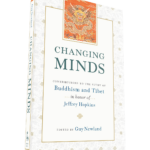
Paperback | eBook
$29.95 - Paperback
Another work where Tsongkhapa’s Lamrim is featured is in Changing Minds: Contributions to the Study of Buddhism and Tibet in Honor of Jeffrey Hopkins. There are three chapters devoted to Tsongkhapa:
- Guy Newland’s Ask a Farmer: Ultimate Analysis and Conventional Existence in Tsongkhapa’s Lam Rim Chen Mo
- Daniel Cozort’s Cutting the Roots of Virtue: Tsongkhapa on the Results of Anger
- Elizabeth Napper’s Ethics as the Basis of a Tantric Tradition: Tsongkhapa and the Founding of the Gelugpa Order
Lotsawa House also includes a translation of these fourteen stanzas.
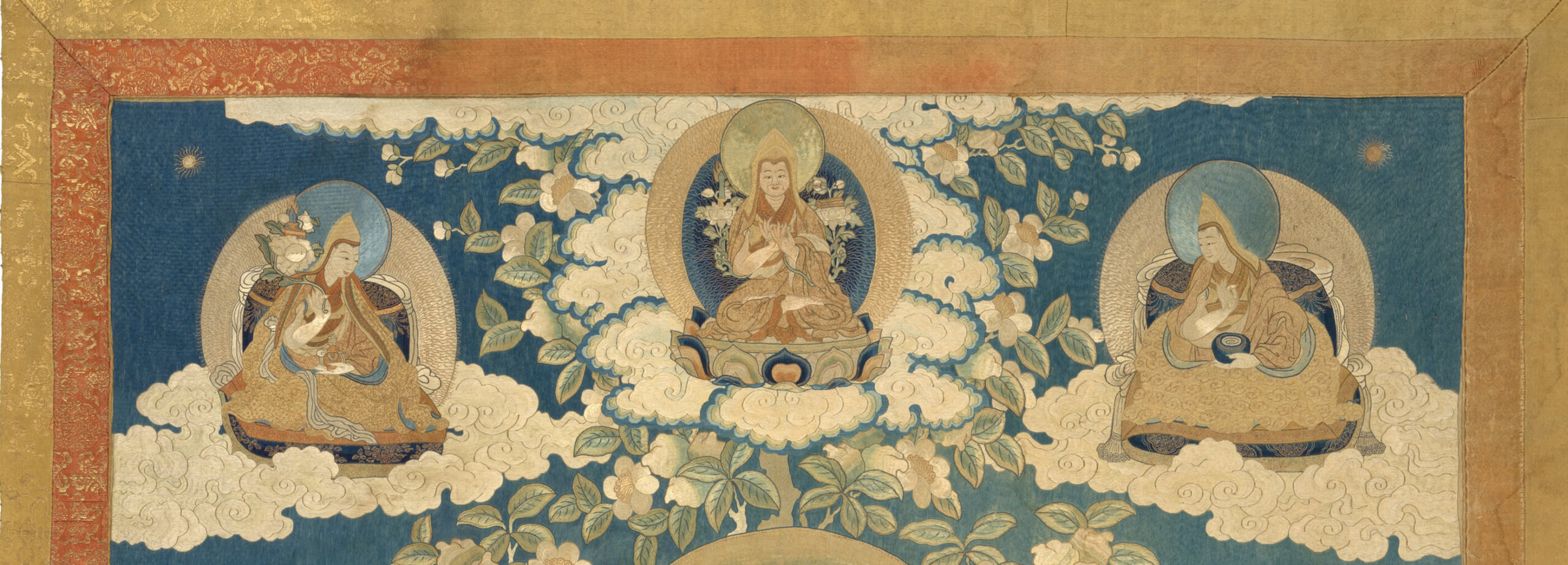
Tsongkhapa on Madhyamaka, The Middle Way School
Tsongkhapa is known for his distinct approach to the middle way philosophical system (madhyamaka) propounded by Indian masters Nāgārjuna (circa 200 CE) and Candrakīrti (circa 600 CE).
"I first went to India in 1972 on a dissertation research Fulbright fellow-ship, where although advised by the Fulbright Commission in New Delhi not to go to Dharmsala because of possible political complications, I went after a brief trip to Banaras. There I found that the Dalai Lama was about to begin a sixteen-day series of four- to six-hour lectures on Tsong-kha-pa Lo-sang-drak-pa’s Medium-Length Exposition of the Stages of the Path to Enlightenment Practiced by Persons of Three Capacities. Despite my cynicism that a governmentally appointed reincarnation could possibly have much to offer, I slowly became fascinated first with the strength and speed of his articulation and then, much more so, with the touching meanings that were conveyed."
-Jeffrey Hopkins, from the Preface to Tsong-kha-pa's Final Exposition of Wisdom

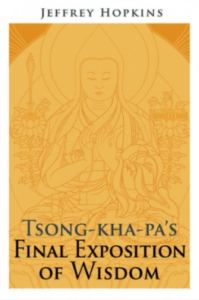
Paperback | eBook
$44.95 - Paperback
Tsong-kha-pa's Final Exposition of Wisdom
By Jeffrey Hopkins
In fourteenth- and fifteenth-century Tibet there was great ferment about what makes enlightenment possible, since systems of self-liberation must show what factors pre-exist in the mind that allow for transformation into a state of freedom from suffering. This controversy about the nature of mind, which persists to the present day, raises many questions. This book first presents the final exposition of special insight by Tsong-kha-pa, the founder of the Ge-luk-pa order of Tibetan Buddhism, in his medium-length Exposition of the Stages of the Path as well as the sections on the object of negation and on the two truths in his Illumination of the Thought: Extensive Explanation of Chandrakirti's Supplement to Nagarjuna's "Treatise on the Middle." It then details the views of his predecessor Dol-po-pa Shay-rap Gyel-tsen, the seminal author of philosophical treatises of the Jo-nang-pa order, as found in his Mountain Doctrine, followed by an analysis of Tsong-kha-pa's reactions. By contrasting the two systems—Dol-po-pa's doctrine of other-emptiness and Tsong-kha-pa's doctrine of self-emptiness—both views emerge more clearly, contributing to a fuller picture of reality as viewed in Tibetan Buddhism. Tsong-kha-pa's Final Exposition of Wisdom brilliantly explicates ignorance and wisdom, explains the relationship between dependent-arising and emptiness, shows how to meditate on emptiness, and explains what it means to view phenomena as like illusions.
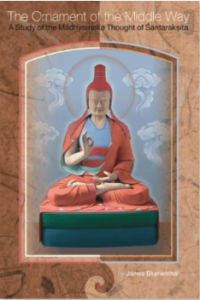
Paperback
$34.95 - Paperback
The Ornament of the Middle Way
A Study of the Madhyamaka Thought of Santaraksita
By James Blumenthal
The late James Blumenthal explores this important text by Shantarakshita and brings in Tsongkhapa’s text on this subject.
Shantarakshita's The Ornament of the Middle Way is among the most important Mahayana Buddhist philosophical treatises to emerge on the Indian subcontinent. In many respects, it represents the culmination of more than 1300 years of philosophical dialogue and inquiry since the time of the historical Buddha Shakyamuni. Shantarakshita set forth the foundation of a syncretic approach to contemporary ideas by synthesizing the three major trends in Indian Buddhist thought at the time (the Madhyamaka thought of Nagarjuna, the Yogachara thought of Asanga, and the logical and epistemological thought of Dharmakirti) into one consistent and coherent system. Shantarakshitas's text is considered to be the quintessential exposition or root text of the school of Buddhist philosophical thought known in Tibet as Yogachara-Svatantrika-Madhyamaka. In addition to examining his ideas in their Indian context, this study examines the way Shantarakshita's ideas have been understood by and have been an influence on Tibetan Buddhist traditions. Specifically, Blumenthal examines the way scholars from the Geluk School of Tibetan Buddhism have interpreted, represented, and incorporated Santaraksita's ideas into their own philosophical project. This is the first book-length study of the Madyamaka thought of Shantarakshita in any Western language. It includes a new translation of Shantarakshita's treatise, extensive extracts from his autocommentary, and the first complete translation of the primary Geluk commentary on Shantarakshita's treatise.
"As a religious reformer, he has been likened to Luther by Western Buddhologists; but as a religious scholar he is regarded in his own culture as a genius whose statue more closely parallels that of Aquinas in Western Christianity. For Tsongkhapa created his own unique interpretation of Buddhist systematics and hermeneutics, in which he synthesized themes from all the Tibetan Buddhist traditions of his era. For these reasons he was praised by the Eight Karmapa as Tibet's chief exponent of ultimate truth, who revived the Buddha's doctrine at a time when the teachings of all four major Tibetan Buddhist lineages were in decline."
-B. Alan Wallace, from the Preface to Balancing the Mind
Paperback | eBook
$24.95 - Paperback
Balancing the Mind
A Tibetan Buddhist Approach to Refining Attention
By B. Alan Wallace
For centuries, Tibetan Buddhist contemplatives have directly explored consciousness through carefully honed and rigorous techniques of meditation. B. Alan Wallace explains the methods and experiences of Tibetan practitioners and compares these with investigations of consciousness by Western scientists and philosophers. Balancing the Mind includes a translation of the classic discussion of methods for developing exceptionally high degrees of attentional stability and clarity by fifteenth-century Tibetan contemplative Tsongkhapa.
Tsongkhapa and the Debate over the Two Truths
Tsongkhapa is famous—and in some circles controversial—for his presentation and positioning of the Prasangika view of Madhyamaka. Any discussion or debate of this subject invariably references Tsongkhapa.
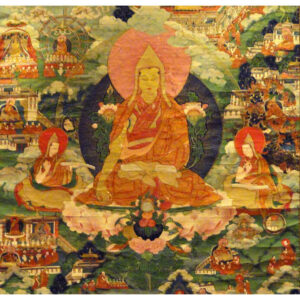
Hardcover | eBook
$78.00 - Hardcover
The Center of a Sunlight Sky
Madhyamaka in the Kagyu Tradition
By Karl Brunnhölzl
This comprehensive work by Karl Brunnholzl explores all facets of Madhyamaka in the Kagyu tradition, but no analysis of Madhyamaka can leave out Tsongkhapa who appears throughout this work. There is a sixty-page section comparing the views of Tsongkhapa to those of Mikyo Dorje’s “whose writing, not only is a reaction to the position of Tsongkhapa and his followers but addresses most of the views on Madhyamaka that were current in Tibet at the time, including the controversial issue of ‘Shentong-Madhyamaka.’”
Paperback| eBook
$39.95 - Paperback
The Adornment of the Middle Way
Shantarakshita's Madhyamakalankara with Commentary by Jamgon Mipham
By Jamgon Mipham, translated by Padmakara Translation Group
For a different take on Shantarakshita's The Ornament of the Middle Way (same text, differently translated title) The Adornment of the Middle Way translated by the Padmakara Translation Group, gives a helpful introduction on the various interpretations. This longer passage offers a glimpse into some of the fault lines in the debate:
"The brilliance of Tsongkhapa’s teaching, his qualities as a leader, his emphasis on monastic discipline, and the purity of his example attracted an immense following. Admiration, however, was not unanimous, and his presentation of Madhyamaka in particular provoked a fierce backlash, mainly from the Sakya school, to which Tsongkhapa and his early disciples originally belonged. These critics included Tsongkhapa’s contemporaries Rongtön Shakya Gyaltsen (1367–1449) and Taktsang Lotsawa (1405–?), followed in the next two generations by Gorampa Sonam Senge (1429–1487), Serdog Panchen Shakya Chokden (1428–1509), and the eighth Karmapa, Mikyö Dorje (1505–1557). All of them rejected Tsongkhapa’s interpretation as inadequate, newfangled, and unsupported by tradition. Although they recognized certain differences between the Prasangika and Svatantrika approaches, they considered that Tsongkhapa had greatly exaggerated the divergence of view. They believed that the difference between the two subschools was largely a question of methodology and did not amount to a disagreement on ontological matters.
Not surprisingly, these objections provoked a counterattack, and they were vigorously refuted by Tsongkhapa’s disciples. In due course, however, the most effective means of silencing such criticisms came with the ideological proscriptions imposed at the beginning of the seventeenth century. These followed the military intervention of Gusri Khan, who put an end to the civil war in central Tibet, placed temporal authority in the hands of the Fifth Dalai Lama, and ensured the rise to political power of the Gelugpa school. Subsequently, the writings of all the most strident of Tsongkhapa’s critics ceased to be available and were almost lost. It was, for example, only at the beginning of the twentieth century that Gorampa’s works could be fully reassembled, whereas Shakya Chokden’s works, long thought to be irretrievably lost, were discovered only recently in Bhutan and published as late as 1975."
-from the Introduction to The Adornment of the Middle Way
The Wisdom Chapter
Jamgön Mipham's Commentary on the Ninth Chapter of The Way of the Bodhisattva
By Jamgon Mipham, translated by Padmakara Translation Group
This work on the Wisdom Chapter of Shantideva’s classic, written more than four centuries after Tsongkhapa, is a presentation of a different view than that expounded by Tsongkhapa. It is, in fact, a superb source for understanding the impact of his Madhyamaka presentation in a wider context, historically and philosophically. The extensive introduction gives a very complete and comprehensive account. In sum:
"In his treatment of the Gelugpa account, Mipham concurs in all important respects with Gorampa and the rest of Tsongkhapa’s earlier critics. Indeed, his critique is possibly even more effective in being expressed moderately and without vituperation. Nevertheless, he is careful never to attack Tsongkhapa personally. Given the fact that Mipham was a convinced upholder of the nonsectarian movement, there is no reason to doubt the sincerity of the humble and respectful manner with which he invariably refers to Tsongkhapa. No sarcasm is detectable in his words:
In the snowy land of Tibet, the great and venerable lord Tsongkhapa was unrivaled in his activities for the sake of the Buddha’s teaching. And with regard to his writings, which are clear and excellently composed, I do indeed feel the greatest respect and gratitude.
There is, however, a striking contrast between Mipham’s veneration of Tsongkhapa, on the one hand, and his penetrating critique of his view, on the other. Mipham’s assessment seems to oscillate between an approbation of some of Tsongkhapa’s positions, regarded as unproblematic expressions of a Svātantrika approach that Mipham valued, and a determination to demolish Tsongkhapa’s philosophical innovations and their pretended Prāsaṅgika affiliations. This discrepancy has led some scholars to accuse Mipham of inconsistency. Closer scrutiny suggests, however, that Mipham’s admittedly complex attitude to Tsongkhapa was in point of fact quite coherent."
-from the Introduction to The Wisdom Chapter
Tsongkhapa's Poetry and Songs of Realization
Paperback
$22.95 - Paperback
Thupten Jinpa’s collection of Tibetan poetry includes two poems by Tsongkhapa including Reflections on Emptiness, which is extracted from a larger work, the rTag tu ngu’i rtogs brjod—a poetic retelling of the story of the bodhisattva Sadāprarudita, who is associated with the 8,000 Verse Prajnamaramita Sutra and A Prayer for the Flourishing of Virtues.
Jinpa presents Tsongkhapa’s poetry first in terms of his mastery of composition and second, in terms of his mastery of the Buddhist path.
First, describing his master of composition, Jinpa writes:
Tsongkhapa’s famous long poem entitled ‘‘A Literary Gem of Poetry’’ uses a single vowel in every stanza throughout the entire length. This is the poem from which come the famous lines:
Good and evil are but states of the heart:
When the heart is pure, all things are pure;
When the heart is tainted, all things are tainted.
So all things depend on your heart.In the original Tibetan, this stanza uses only the vowel a. Of course, this kind of literary device can never be reproduced in a translation, whatever the virtuosity and command of the translator.
Second, describing his mastery of the Buddhist path Jinpa states:
To a contemporary reader, Tsongkhapa’s famous ‘‘Prayer for the Flourishing of Virtues’’ gives an insight into the deepest ideals of a dedicated Tibetan Buddhist practitioner; it presents a map of progressive development on the path. Beyond this, the mystic must utterly transform the very root of his identity and the perceptions that arise from it. From the ordinary patterns of action and reaction that make up our psyche and emotional life, the meditator must move toward a divine state of altered consciousness where all realities, including one’s own self, are manifested in their enlightened forms. In other words, the meditator must perfect all dimensions of his or her identity and experience, including rationality, emotion, intuition, and even sexuality. This, in Tibetan Buddhism, is the mystical realm of tantra.
Tsongkhapa and Tantra
A brief note. For those unfamiliar or only exposed through books, we strongly encourage readers to study tantra under the guidance of a qualified teacher. Book reading can only take you so far as the transmission of tantric teaching is about more than what can be put on paper.
This work is analogous to the tantra version of the Lamrim Chenmo, presenting tantra from the position of the sarma, ie., the 'new school,' or later transmission from India.
There are three books by Tsongkhapa and His Holiness the Dalai Lama that form a series focused on Tsongkhapa's Great Exposition of Secret Mantra. In this text, Tsongkhapa presents the differences between sutra and tantra and the main features of various systems of tantra. Each of the three books below begins with the Dalai Lama contextualizing and commenting on the points presented in Tsongkhapa's text, followed by a translation of the corresponding part of the text itself.
Paperback
$29.95 - Paperback
In Volume 1: Tantra in Tibet, the foundations of motivation, refuge, and the Hinayana and Mahayana paths are presented. He then gives an overview of tantra, the notion of Clear Light, the greatness of mantra, and initiation or empowerment.
This revised work describes the differences between the Great Vehicle and Lesser Vehicle streams in the sutra tradition, and between the sutra tradition and that of tantra generally. It includes highly practical and compassionate explanations from H.H. the Dalai Lama on tantra for spiritual development; the first part of the classic Great Exposition of Secret Mantra text; and a supplement by Jeffrey Hopkins on the difference between the Vehicles, emptiness, psychological transformation, and the purpose of the four tantras.
Paperback
$29.95 - Paperback
In Volume II: Deity Yoga, His Holiness discusses deity yoga at length with a particular focus on action and performance tantras (the first two categories of tantra as described in the sarma, or “new translation” schools).
This revised work describes the profound process of meditation in Action (kriya) and Performance (carya) Tantras. Invaluable for anyone who is practicing or is interested in Buddhist tantra, this volume includes a lucid exposition of the meditative techniques of deity yoga from H.H. the Dalai Lama; the second and third chapters of the classic Great Exposition of Secret Mantra text; and a supplement by Jeffrey Hopkins outlining the structure of Action Tantra practices as well as the need for the development of special yogic powers.
Paperback
$27.95 - Paperback
in Volume III: Yoga Tantra the Dalai Lama details the practice of the next level of tantra, yoga tantra. With a preliminary overview of the motivation, His Holiness explains this level, which focuses on internal yoga, which here means the union of deity yoga with the wisdom of realizing emptiness. He details the yoga, both that with and that without signs, and then briefly explains how gaining stability in these practices is the foundation for some other practices that lead to mundane and extraordinary “feats.”
This work opens with the Dalai Lama presenting the key features of Yoga Tantra then continues with the root text by Tsongkhapa. This is followed by an overview of the central practices by Khaydrub Je. Jeffrey Hopkins concludes the volume with an outline of the steps of Yoga Tantra practice, which is drawn from the Dalai Lama’s, Tsongkhapa’s, and Khaydrub Je’s explanations.
An explanation of the highest yoga tantra is not included in these works, but an excellent resource is Daniel Cozort's Highest Yoga Tantra.
Paperback
$39.95 - Paperback
The Six Yogas of Naropa
Tsongkhapa's Commentary
By Glenn H. Mullin
Tsongkhapa's commentary entitled A Book of Three Inspirations: A Treatise on the Stages of Training in the Profound Path of Naro's Six Dharmas is commonly referred to as The Three Inspirations. Anyone who has read more than a few books on Tibetan Buddhism will have encountered references to the Six Yogas of Naropa, a preeminent yogic technology system. The six practices—inner heat, illusory body, clear light, consciousness transference, forceful projection, and bardo yoga—gradually came to pervade thousands of monasteries, nunneries, and hermitages throughout Central Asia over the past five and a half centuries.
Paperback
$27.95 - Paperback
The Practice of the Six Yogas of Naropa
By Glenn H. Mullin
Another text that is included in Tsongkhapa’s collected works is the short Practice Manual on the Six Yogas. This is included in the wider collection of texts on this practice titled The Practice of the Six Yogas of Naropa. Also included in this book are works by Tilopa, Naropa, Je Sherab Gyatso, and the First Panchen Lama.
From the Six Yogas of Naropa:
"Tsongkhapa's treatise on this system of tantric practice ... became the standard guide to the Naropa tradition at Ganden Monastery, the seat he founded near Lhasa in 1409. Ganden was to become the motherhouse of the Gelukpa school, and thus the symbolic head of the network of thousands of Gelukpa monasteries that sprang up over the succeeding centuries across Central Asia, from Siberia to northern India. A Book of Three Inspirations has served as the fundamental guide to Naropa's Six Yogas for the tens of thousands of Gelukpa monks, nuns, and lay practitioners throughout that vast area who were interested in pursuing the Naropa tradition as a personal tantric study. It has performed that function for almost six centuries now.
Tsongkhapa the Great's A Book of Three Inspirations has for centuries been regarded as special among the many. The text occupies a unique place in Tibetan tantric literature, for it in turn came to serve as the basis of hundreds of later treatments. His observations on various dimensions and implications of the Six Yogas became a launching pad for hundreds of later yogic writers, opening up new horizons on the practice and philosophy of the system. In particular, his work is treasured for its panoramic view of the Six Yogas, discussing each of the topics in relation to the bigger picture of tantric Buddhism, tracing each of the yogic practices to its source in an original tantra spoken by the Buddha, and presenting each within the context of the whole. His treatise is especially revered for the manner in which it discusses the first of the Six Yogas, that of the 'inner heat.' As His Holiness the present Dalai Lama put it at a public reading of and discourse upon the text in Dharamsala, India, in 1991, 'the work is regarded by Tibetans as tummo gyi gyalpo, the king of treatments on the inner heat yoga.' Few other Tibetan treatises match it in this respect."
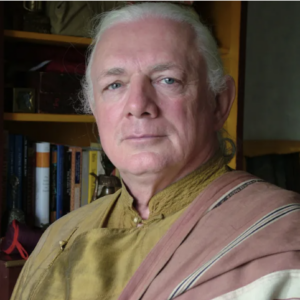
Paperback | eBook
$39.95 - Paperback
This work has three main sections: an overview of Mahamudra, the First Panchen’s text The Main Road of the Triumphant Ones, and a commentary by the Dalai Lama. The author contextualizes the selection saying that the tradition of Mahamudra in the Gelug tradition comes through Tsongkhapa.
Other Notable Works Related to Tsongkhapa
Paperback | eBook
$39.95 - Paperback
Tibetan Literature
Studies in Genre
Edited by Jose Cabezon and Roger R. Jackson
Tibetan Literature: Studies in Genre is a collection by leading Tibetologists. The immensity of Tibet's literary heritage, unsurprisingly, is filled with references to Tsongkhapa across a wide range of subjects. Just a sampling of them include: the establishment of the Gelug order; the monastic curriculum; debate manuals; establishment of Ganden; a comparison with Milarepa; the controversies about his views; a classification of his texts; and a lot more.
Paperback | eBook
$29.95 - Paperback
Mind in Tibetan Buddhism
By Lati Rinpoche, Edited and translated by Elizabeth Napper
Mind in Tibetan Buddhism is an oral commentary on Geshe Jampel Sampel's Presentation of Awareness and Knowledge Composite of All the Important Points, Opener of the Eye of New Intelligence. This topic, lorig in Tibetan, was not one on which Tsongkhapa wrote a dedicated text, but he does include it in an introduction to Dharmakirti’s Seven Treatises and one of his sections includes a brief presentation on lorig. Tsongkhapa is brought up throughout this book.
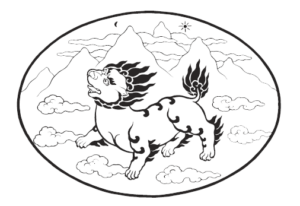
Tsongkhapa is also referenced in about 60 articles on shambhala.com, mostly from the Snow Lion newsletter archive.
Additional Resources


More can be found on Atisha's life on Treasury of Lives
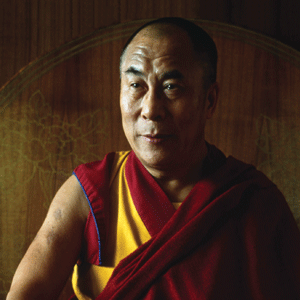
His Holiness the Dalai Lama: A Guide for Readers

See also: Tsongkhapa: A Guide to His Life and Works | Kalachakra Tantra Reader Guide |
Works by the Dalai Lamas | Readers Guide to His Holiness the Fourteenth Dalai Lama
Other Tibetan Buddhist Traditions: Bön | Gelug | Jonang | Kalachakra | Kagyu | Kadam | Nyingma | Sakya | Zhije & Chöd
DALAI LAMA TITLES
About His Holliness the 14th Dalai Lama
For this latest installment of our Great Masters series, we turn to a contemporary master, His Holiness the Fourteenth Dalai Lama, often referred to by Tibetans as Gyalwa Rinpoche or Kundun. As with previous posts, this is not intended to be a complete biography but rather a look at His Holiness's teachings through the lens of his books, mostly the two dozen books published by us, though a few others are also included here. For those looking for more in-depth a biography, His Holiness's autobiography, Freedom in Exile, is an excellent starting point.
While His Holiness is not formally the head of Tibetan Buddhism (there never was one) nor even of the Gelug tradition (that title belongs to the head of Ganden Monastery, the Ganden Tripa), he is regarded as the figurehead and ambassador of Tibetan Buddhism and the Tibetan people. Considered the emanation of Avalokiteshvara, he is beloved by practitioners of all the Tibetan traditions. He has taken initiations and teachings from the many branches of the Tibetan Buddhist tree and has worked tirelessly to preserve the rich set of lineages. Most importantly, His Holiness is a living example of the Buddha's teaching that through study and practice, we can all embody the sublime qualities that are to be cultivated on the path.
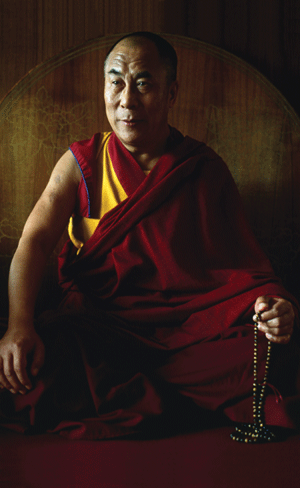
About the Dalai Lama's Books
His Holiness's books in English fall into two general categories: books for general readers who may be interested in what Buddhism has to say about contemporary issues like ethics, science, how the mind works, the environment, etc., and secondly, books specifically for Buddhists on the path. This latter category can be further broken down into overviews of the Buddhist path; the bodhisattva path of the Mahayana; Tantra; and finally Dzogchen and Mahamudra
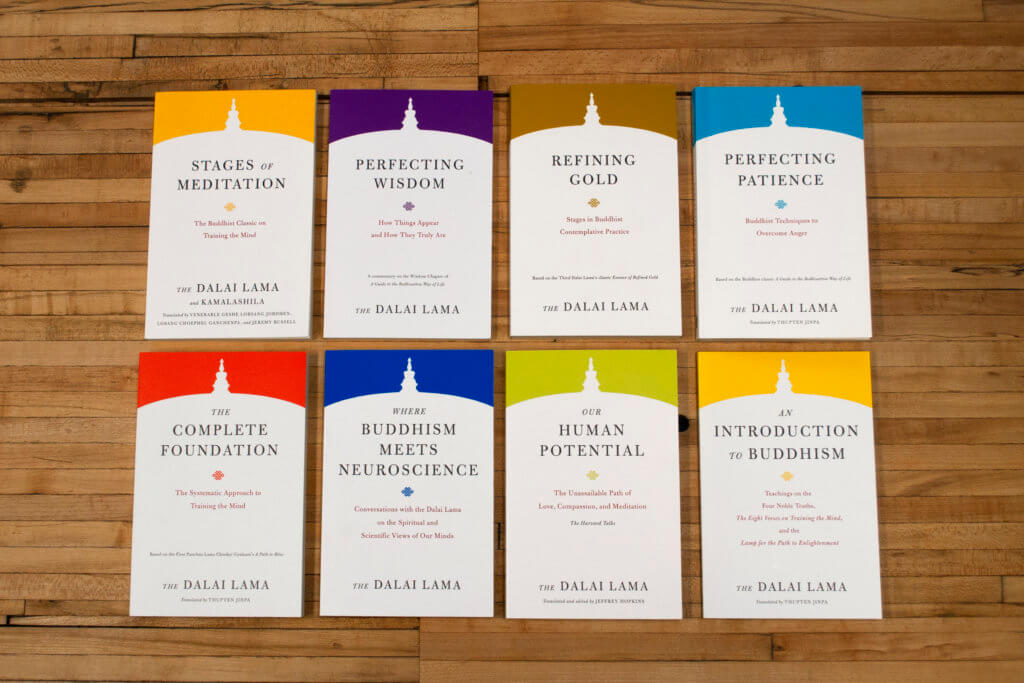
For General Readers
The Pocket Dalai Lama, which can fit in a shirt pocket, is a sampler of His Holiness's writings across the many more secular topics he often addresses to broader audiences, including religion, happiness, democracy and human rights, forgiveness, nonviolence, and world peace.
Policy of Kindness: An Anthology of Writings by and about the Dalai Lama, published shortly after he was awarded the Nobel Peace Prize, is an introduction to his background and daily life and his views and teachings. Currently available only as an eBook.
Paperback $12.95 - Paperback
One of the most influential Buddhist leaders of our time, His Holiness the Fourteenth Dalai Lama is a Nobel Peace Laureate and the exiled spiritual head of the Tibetan people. A tireless teacher and writer, he is the author of dozens of widely acclaimed works, including The Art of Happiness and The Heart of Meditation—and this compact collection brings together a selection of inspiring short teachings from many of his popular books. Addressing a broad range of subjects, such as nonviolence, impermanence, religion, politics, and human rights, these wise words show the power of goodness even in the most uncertain of times.
A Future We Can Love: How We Can Reverse the Climate Crisis with the Power of Our Hearts and Minds
While A Future We Can Love is not authored by His Holiness, it is based on a conversation between he and Greta Thunberg. He appears throughout the book, and the audiobook includes him speaking passages that are quoted at length in the book.
A Future We Can Love shares the words of these two great figures, generations apart, bringing them into dialogue with cutting-edge climate scientists, activists, and spiritual leaders to start a world-changing conversation. Listeners embark on a four-part journey toward active hope in the face of the climate crisis: from knowledge of climate science through the capacity for change, to the will that is needed and the actions we can take.
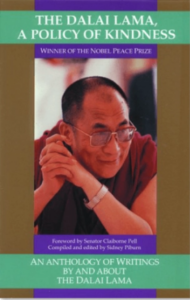
This book offers a comprehensive view of the Dalai Lama—both his personal life and his thoughts on issues of global concern. It provides an engaging picture of a man whose goodwill, understanding, and practicality have brought him respect from world leaders and the acclaim of millions around the world.
Conversations with the Dalai Lama on Science and Buddhist Fundamentals
The following titles are more specific on what the teachings of the Buddha and his spiritual heirs offer to humanity.
Where Buddhism Meets Neuroscience (previously published as Consciousness at the Crossroads: Conversations with the Dalai Lama on Brain Science and Buddhism) records the Dalai Lama's conversations with many leading scientists who specialize in how the brain works. The Western approach of the scientific method meets the Buddhist approach of the science of experience. Questions of perception, dualism, categories of consciousness, memory, dreams, the nature of mental illness, and the mind during and after death are all explored. Discussing the difference between the brain and the mind, he states,
"Generally speaking, awareness, in the sense of our familiar, day-to-day mental processes, does not exist apart from or independent from the brain, according to the Buddhist view. But Buddhism holds that the cause of awareness is to be found in a preceding continuum of awareness from one life to another. Whence does this awareness arise initially? It must arise fundamentally not from a physical base but from a preceding continuum of awareness. "
In Answers: Discussions with Western Buddhists, His Holiness responds to a wide range of questions (from Western non-Buddhists as well!), on topics such as the idea of a creator god, how to reconcile Western physics and Buddhist teachings, Buddhism's essence versus its cultural forms, vipassana in sutra and tantra, tantric meditation, and guru devotion.
Kindness, Clarity, and Insight, one of the most widely read of His Holiness's books, includes a series of talks covering the fundamentals of Buddhism (the four noble truths, karma, the six perfections) as well as topics appropriate for a general audience, like religious values, compassion in global politics, and religious harmony. On this latter topic, he says,
"Philosophical teachings are not the end, not the aim, not what you serve. The aim is to help and benefit others. . . . If we go into the differences in philosophy and argue with and criticize each other, it is useless. . . . Better to look at the purpose of the philosophies and to see what is shared-an emphasis on love, compassion, and respect for a higher force."
Paperback | eBook $18.95 - Paperback
Is the mind an ephemeral side effect of the brain’s physical processes? Are there forms of consciousness so subtle that science has not yet identified them? How does consciousness happen? Organized by the Mind and Life Institute, this discussion addresses some of the most troublesome questions that have driven a wedge between Western science and religion. Read More
Paperback | eBook $18.95 - Paperback
Answers: Discussions with Western Buddhists
In India, at the place where the Buddha attained enlightenment, it became a well-established tradition for the Dalai Lama to spend several days each year giving teachings to Buddhists from all over the world. Following his teachings, he held informal group discussions with Western students of Buddhism. In these lively exchanges, the Dalai Lama exhibits clear and penetrating insight into issues that are most important to Western students. Read More
$16.95 - Paperback
Kindness, Clarity, and Insight: The Fundamentals of Buddhist Thought and Practice
This beloved classic brings together in one volume all the major themes of the Dalai Lama’s teachings. Drawn from the lectures he gave during his first three visits to North America, the book covers the core subject matter of Tibetan Buddhism, as presented for the first time to an English-speaking audience. The chapters are arranged developmentally from simple to complex topics, which include the luminous nature of the mind, the four noble truths, karma, the common goals of the world’s religions, meditation, deities, and selflessness. Read More
In the groundbreaking Healing Emotions: Conversations with the Dalai Lama on Mindfulness, Emotions, and Health, the Dalai Lama discusses this range of topics with Daniel Goleman, Jon Kabat-Zin, Sharon Salzberg, and many leading scientists.
His Holiness' further ideas about the intersection of Buddhism and science, and how the former can inform the latter are captured in Gentle Bridges: Conversations with the Dalai Lama on the Sciences of Mind.
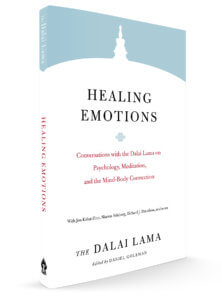
$19.95 - Paperback
Can the mind heal the body? The Buddhist tradition says yes—and now many Western scientists are beginning to agree. These discussions between the Dalai Lama and this group of prominent physicians, psychologists, philosophers, and behaviorists shed new light on the mind-body connection. Read More
$17.95 - Paperback
Gentle Bridges: Conversations with the Dalai Lama on the Sciences of Mind
What is the essence of the mind? Could computers ever have consciousness? Can compassion be learned? When does consciousness enter the human embryo? These are just some of the many questions that were discussed during a historic meeting that took place between several prominent Western scientists and the Dalai Lama. Gentle Bridges is a chronicle of this extraordinary exchange of ideas. Read More
Books for Buddhists
For Buddhists, His Holiness's books fall roughly under the following categories (click to jump to each one): overviews of the Buddhist path; the Great Vehicle of the Mahayana; Tantra; Dzogchen and Mahamudra.
Lam Rim (Stages of the Path)
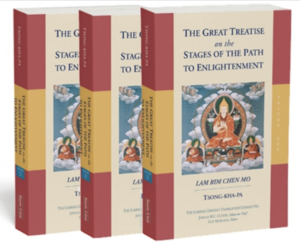
Several of His Holiness's books fall specifically under the category of Lam Rim teachings, or graduated stages of the path to enlightenment. Lam Rim teachings combine all the core practices of the Hinayana, Mahayana, and Vajrayana Buddhist traditions as taught in unbroken succession from the Buddha down to today. The Lam Rim teachings are a corpus of teachings that began with Atisha's The Lamp for the Path to Enlightenment, which is itself based on the Maitreya/Asanga text the Abhisamayalamkara, or Ornament of Clear Realization, on which there is a rich body of literature in Tibetan. What many consider the most detailed of Lam Rim teachings is Tsongkhapa's Great Treatise on the Stages of the Path to Enlightenment.
$34.95 - Paperback
Volume I
This first of three volumes covers all the practices that are prerequisite for developing the spirit of enlightenment (bodhicitta).
$28.95 - Paperback
This second of three volumes covers the deeds of the bodhisattvas, as well as how to train in the six perfections.
$34.95 - Paperback
This third and final volume contains a presentation of the two most important topics in the work: meditative serenity (śamatha) and supramundane insight into the nature of reality (vipaśyanā).
Refining Gold: Stages in Buddhist Contemplative Practice (previously published as The Path to Enlightenment) is His Holiness's section-by-section commentary on The Essence of Refined Gold, penned by the Third Dalai Lama, Sonam Gyatso, which itself is a distillation of Tsongkhapa's Great Treatise. As with other Lam Rim texts, it covers the entire path, and while Lam Rim is typically considered specific to the Gelug tradition, as His Holiness says, "in that its source is none other than the doctrines of the Buddha as gathered and clarified by prophesied Indian masters such as Nagarjuna and Asanga, every Buddhist tradition should be able to see reflections of their own practices through the Lam Rim. "
In The Complete Foundation: The Systematic Approach to Training the Mind (previously published as The Path to Bliss: A Practical Guide to Stages of Meditation), His Holiness presents the Lam Rim of the Fourth Panchen Lama, Lobsang Chokyi Gyaltsen, entitled The Path to Bliss Leading to Omniscience. He gives the origin of Lam Rim teachings and then goes into the preliminary practices followed by the main meditation practices of the Lam Rim.
Another recent book on Lam Rim is From Here to Enlightenment: An Introduction to Tsong-kha-pa's Classic Text The Great Treatise on the Stages of the Path to Enlightenment. This is a concise distillation of the entire work and a great starting point. There is a very moving, short video of His Holiness explaining how precious Tsongkhapa's text is to him. This is a great way to approach this classic text, and His Holiness makes it very accessible.
$17.95 - Paperback
Refining Gold: Stages in Buddhist Contemplative Practice
In this extensive teaching, the Dalai Lama beautifully elucidates the meaning of the path to enlightenment through his own direct spiritual advice and personal reflections. Based on a very famous Tibetan text, this teaching presents in practical terms the essential instructions for the attainment of enlightenment. Its direct approach and lucid style make Refining Gold one of the most accessible introductions to Tibetan Buddhism ever published. Read More
$22.95 - Paperback
The Complete Foundation: A Systematic Approach to Training the Mind
Clear, eloquent, simple, and profound, His Holiness’s teachings are easily accessible to beginning practitioners yet richly nourishing to those more advanced in practice. In The Complete Foundation, the Dalai Lama shows how visualization, reason, and contemplation can be systematically crafted to enhance personal development. Beginning with practices designed to create an effective mental outlook, His Holiness skillfully guides the student to more advanced techniques for developing the mind’s deepest potential and happiness. Read More
$19.95 - Paperback
When the Dalai Lama was forced into exile in 1959, he could take only a few items with him. Among these cherished belongings was his copy of Tsong-kha-pa’s classic text The Great Treatise on the Stages of the Path to Enlightenment. This text distills all the essential points of Tibetan Buddhism, clearly unfolding the entire Buddhist path. Read More
Multi-Theme Works
The Buddhism of Tibet begins with a concise overview of the entire Tibetan Buddhist path from sutra to tantra. This is followed by a translation of His Holiness's text explicating the meaning of emptiness entitled The Key to the Middle Way. Supplementing these two sections is a translation of Nagarjuna's Precious Garland-a text also published as a book by Snow Lion under the same title with more extensive background and including the Tibetan-and finally the Seventh Dalai Lama's The Song of the Four Mindfulnesses, a short poem encapsulating the essentials of both sutra and tantra.
While addressing a Western audience, the lectures contained in Our Human Potential: The Unassailable Path of Love, Compassion, and Meditation (previously published as The Dalai Lama at Harvard) go deep into the fundamental teachings of Buddhism and its philosophy. He presents the ground of the path, covering topics such as the condition of cyclic existence, karma, emptiness, and the meditation techniques for liberation, but then he bridges these topics to the universal ideals of altruism, love for enemies, and wisdom.
Perfecting Patience: Buddhist Techniques to Overcome Anger (previously published as Healing Anger) covers the whole Buddhist path but focuses on the specific topic of overcoming the powerful emotion of anger by cultivating patience as prescribed in Shantideva's classic text, The Way of the Bodhisattva.
$22.95 - Paperback
Unlike most books by the Dalai Lama which are edited compilations of talks that he has given, this book consists of two texts that he himself wrote and two that he chose—all especially aimed at helping Western readers become better grounded in Buddhism. He wrote "The Buddhism of Tibet" and "The Key to the Middle Way" sections to explain the principal topics and central practices of Buddhism. Read More
$19.95 - Paperback
(previously published under the title The Dalai Lama at Harvard)
When His Holiness the Dalai Lama gave a series of lectures at Harvard University, they fulfilled magnificently his intention of providing an in-depth introduction to Buddhist theory and practice. He structured the presentation according to the teachings of the Four Noble Truths and expanded their meaning to cover most of the topics of Tibetan Buddhism. Read More
$18.95 - Paperback
Perfecting Patience: Buddhist Techniques to Overcome Anger
All of the world’s major religions emphasize the importance of love, compassion, and tolerance. This is particularly true in the Buddhist traditions, which unanimously state that compassion and love are the foundation of all paths of practice. To cultivate the potential for compassion and love inherent within us, it is crucial to counteract their opposing forces of anger and hatred. In Perfecting Patience, the Dalai Lama shows how, through the practice of patience and tolerance, we can overcome the obstacles of anger and hatred. Read More
In the first half of An Introduction to Buddhism(previously published as Lighting the Way), His Holiness covers the Four Noble Truths and mind training, or lojong, as laid out by Kadampa master Langri Tangpa. The second half is devoted to a commentary on Atisha's Lamp for the Path to Enlightenment, the source text upon which the Lam Rim, or graduated stages of the path, is based. A longer commentary on this text by the late Geshe Sonam Rinchen is also available.
An Introduction to Buddhism is also is available as an audiobook:
$16.95 - Paperback
Mahayana
While many of the books above also include presentations of the Mahayana, the following are deep dives into some of the most important Mahayana texts and ones His Holiness has returned to many times in his teachings around the world.
His Holiness has frequently taught on Shantideva's Bodhicaryavatara, or Way of the Bodhisattva, sometimes translated as Guide to the Bodhisattva's Way of Life, considered one of the most important texts of the Mahayana canon. The Dalai Lama said that Shantideva "turned his own weapons upon himself, doing battle with his negative emotions. Therefore, when we teach or listen to this text, it is important that we do so in order to progress spiritually, rather than making it simply a subject of academic study. " Having received the transmission of this text from Khunu Rinpoche, who received it from Patrul Rinpoche (whose teachings on the text were said to be accompanied by auspicious signs like the blossoming of flowers with an incredible number of petals), His Holiness has prized this text and taught it widely.
In For the Benefit of All Beings, translated by the Padmakara Translation Group, who also translated one of the most popular versions of the Way of the Bodhisattva, His Holiness gives an overview and commentary on each chapter of the text, distilling the key messages on the benefits of bodhichitta, offering and purification, carefulness, attentiveness, patience, endeavor, concentration, wisdom, and dedication.
This is also available in our Pocket Series as The Bodhisattva Guide and as an audio download.
$21.95 - Paperback
For the Benefit of All Beings: A Commentary on The Way of the Bodhisattva
The fourteenth Dalai Lama, a living embodiment of the bodhisattva ideal, presents here detailed practical guidance based on sections of The Way of the Bodhisattva by Shantideva, the best-known text of Mahayana Buddhism. The Dalai Lama explains this classic and beloved work, showing how anyone can develop a truly "good heart" and the aspiration for the enlightenment of all beings. Read More
$12.95 - Paperback
One of the most beloved of all Buddhist texts, The Way of the Bodhisattva is a practical guide to generating the qualities of love, compassion, generosity, and patience. In this commentary on key sections of the text, the Dalai Lama shows how any of us can develop a truly “good heart,” and why aspiring toward the happiness and enlightenment of others is central to any genuinely spiritual path. Read More
*Note: This is the small format edition of For the Benefit of Beings
$16.95 - Paperback
The ninth chapter or "Wisdom Chapter" of the Bodhicaryavatara, is considered one of the most profound and requires deep study and practice to truly understand. In Perfecting Wisdom: How Things Appear and How They Truly Are (previously published as Transcendent Wisdom), the focus is this chapter. Here His Holiness goes deep into the subjects of the methods needed to cultivate wisdom, what identity-less-ness means, and how the notion of true existence is refuted.
Another set of texts His Holiness has taught on are the so-called Bhavanakrama ( "Stages of Meditation ") texts of Kamalashila, who composed three versions of this text in Tibet. In Stages of Meditation: The Buddhist Classic on Training the Mind, the Dalai Lama gives the fundamental teachings on how to meditate, based on the middle-length version of these texts. He also relates very moving circumstances about how he came to receive the transmission of this text from the Sakya abbot Sangye Tenzin in Bodhgaya.
On a related note, another text His Holiness frequently teaches on is the Eight Verses for Training the Mind, written by Langri Tangpa. The most common teachings on lojong, or mind training, are the Seven-Point Mind Training, by Chekawa Yeshe Dorje. Both of these texts derive from the teaching of Atisha Dipankara Shrijnana, the great Bengali master who went to Tibet and reinvigorated the traditions there. Atisha's famous Bodhipathiapradipa or A Lamp for the Path to Enlightenment is discussed above.
$19.95 - Paperback
Tantra
In the foreword to The Practice of Kalachakra, the Dalai Lama explains the importance of tantra:
"Tantric practice is more powerful than the general sutra trainings for a number of reasons. One of these is that it fully integrates the factors of method and wisdom. In the sutra path one meditates on emptiness, or the non-inherent existence of phenomena, within the framework of the compassionate aspiration to highest enlightenment. Meditation on emptiness is the factor of wisdom, and the bodhisattva aspiration is method. However, in the sutra path these two cannot be generated simultaneously within one moment's consciousness by a practitioner on ordinary levels. In the tantric path, as method one generates the mandala and deities, and then focuses on their empty nature. In this way method and wisdom arise simultaneously in the entity of one mind."
While traditionally works on this subject were kept secret and not distributed widely, the fact that there has been so much misunderstanding and misappropriation of tantra and its methods made the Dalai Lama felt that "translating and distributing an authoritative book may help to clear away the false superimpositions." The books resulting from this wish are below.
$19.95 - Paperback
A key element in tantric practice is guru yoga, as it acts as a foundation upon which the rest of the tantric framework is built. In The Union of Bliss and Emptiness: Teachings on the Practice of Guru Yoga, the Dalai Lama explains this practice, using the Lama Chopa of Lobsang Chokyi Gyalsten, the Fourth Panchen Lama, as the vehicle.
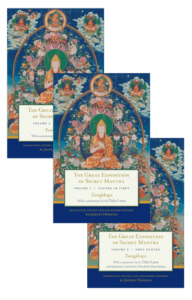
There are three books by His Holiness that form a series focused on Tsongkhapa's Great Exposition of Secret Mantra, sometimes translated as The Great Exposition of Secret Mantra, which, along with his Great Treatise on the Stages of the Path to Enlightenment, is considered by many his most important work. In this text Tsongkhapa presents the differences between sutra and tantra and the main features of various systems of tantra. Each of the three books below begins with the Dalai Lama contextualizing and commenting on the points presented in Tsongkhapa's text, followed by a translation of the corresponding part of the text itself.
In Volume 1, Tantra in Tibet, His Holiness first lays out the foundation of motivation, refuge, and the Hinayana and Mahayana paths. He then gives an overview of tantra, the notion of Clear Light, the greatness of mantra, and initiation or empowerment.
$29.95 - Paperback
Continuing his commentary in Volume II Deity Yoga, His Holiness discusses deity yoga at length with a particular focus on action and performance tantras (the first two categories of tantra as it is described in the sarma, or "new translation " schools).
$29.95 - Paperback
Then in Volume III Yoga Tantra the Dalai Lama details the practice of the next level of tantra, yoga tantra. With a preliminary overview of the motivation, His Holiness explains this level, which focuses on internal yoga, which here means the union of deity yoga with the wisdom of realizing emptiness. He details the yoga, both that with and that without signs, and then briefly explains how gaining stability in these practices is the foundation for some other practices that lead to mundane and extraordinary "feats."
$27.95 - Paperback
An explanation of highest yoga tantra is not included in these works, but an excellent resource is Daniel Cozort's Highest Yoga Tantra.
His Holiness, who has given the Kalachakra empowerment to hundreds of thousands of the devoted in Asia and the West, discusses the practice in From the Heart of Chenrezig, a collection of teachings on Tantra by eight of the Dalai Lamas.
Dzogchen and Mahamudra
Dzogchen and Mahamudra are two related bodies of teachings and practices that are considered by many to be the pinnacle of Vajrayana Buddhism.
$39.95 - Paperback
Mahamudra, or The Great Seal, while often associated in the West with the Kagyu school, has a rich set of traditions in the Sakya and Gelug schools as well. The latter tradition, which has both sutra- and tantra-level teachings on the subject, is revealed in The Gelug/Kagyu Tradition of Mahamudra. This book is based on the text by the First Panchen Lama, Khedrup Je, entitled The Main Road of the Triumphant Ones, which is included in translation. His Holiness presents a commentary both on the root text and Khedrup Je's auto-commentary.
$21.95 - Paperback
The Dalai Lama has received empowerments from all the main Tibetan lineages, including, extensively, that of the Nyingma. He is a student of the late Dilgo Khyentse Rinpoche, who gave him extensive instruction in the practices of Dzogchen, or Great Perfection.
His Holiness has said,
As is said in an oral transmission by the great lama Jamyang Khyentse Chokyi Lodro, when the great Nyingmapa adept Longchen Rabjam gives a presentation of the ground, path, and fruit, he does so mainly from the perspective of the enlightened state of a Buddha, whereas the Sakyapa presentation is mainly from the perspective of the spiritual experience of a yogi on the path, and the Gelukpa presentation is mainly from the perspective of how phenomena appear to ordinary sentient beings. His statement appears to be worthy of considerable reflection; through it many misunderstandings can be removed.
Longchen Rabjam's view is implicitly presented in Dzogchen: The Heart Essence of the Great Perfection, in which His Holiness teaches on Patrul Rinpoche's commentary to Garab Dorje's famous Three Words That Strike the Vital Point, also using other texts such as Longchenpa's Cho Ying Dzod, or Precious Treasury of the Fundamental Nature.
$16.95 - Paperback
His Holiness' latest book, The Heart of Meditation: Discovering Innermost Awareness, he teaches on Dzogchen (rendered by the translator here as the Great Completeness) simply but thoroughly, using as his reference a visionary poem by the nineteenth-century master Patrul Rinpoche to show that insight can never be separated from compassion. Through the practice, we can access our innermost awareness and live our lives in a way that acknowledges it and manifests it. The wisdom and compassion that arise from such insight are critical, His Holiness teaches, not only to individual progress in meditation but to our collective progress toward peace in the world.
We will close this Great Masters post with a quote from His Holiness included in Matthieu Ricard's anthology On the Path to Enlightenment:
"When the teachings say we need to reduce our fascination with the things of this life, it does not mean that we should abandon them completely. It means avoiding the natural tendency to go from elation to depression in reaction to life's ups and downs, jumping for joy when you have some success, or wanting to jump out the window if you do not get what you want. Being less concerned about the affairs of this life means assuming its ups and downs with a broad and stable mind."
Discover More Reader's Guides, Articles, and Resources
SNOW LION NEWSLETTER ARCHIVE

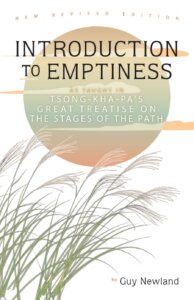
Tsong-kha-pa explains that when we understand the compatibility of dependent arising and emptiness, we see that nihilistic misreadings of Madhyamaka in fact have much in common with the eternalist extremes of those who cling to the idea of intrinsic nature. To understand this, consider that the basic question—the compatibility of emptiness and dependent arising—can be posed as follows: Can A produce B when A is empty? If A is devoid of intrinsic nature, how can it produce B? Suppose that A, the cause, is a seed and B, the effect, is a sprout. Now let’s consider three answers to these questions: (1) the answer of the essentialists (including many Buddhists), (2) the answer of those who, in interpreting Madhyamaka, negate too much, and (3) the answer of Tsong-kha-pa.
Essentialists: A seed cannot produce a sprout if the seed is empty of intrinsic nature. If the seed does not have, in its intrinsic nature, the capacity to produce a sprout, then a sprout will not be produced from the seed. Since sprouts are produced, we know that their causes, seeds, must have in their essential nature the power to produce sprouts.
Those who negate too much: We agree that a seed cannot produce a sprout when the seed is empty of intrinsic nature. If the seed does not have, in its intrinsic nature, the capacity to produce a sprout, then a sprout will not be produced from the seed. However, Madhyamaka analysis shows that seeds have no intrinsic nature; thus, it follows that sprouts are not produced. All production, all existence, is a delusion.
Tsong kha pa: A seed can produce a sprout when the seed is empty of intrinsic nature, as is frequently observed in the world. A seed does not need an intrinsic nature in order to produce a sprout. In fact, it is only because seeds lack intrinsic nature that dependent arising can take place as observed.
From Introduction to Emptiness: As Taught in Tsong-kha-pa’s Great Treatise on the Stages of the Path by Guy Newland

Running (Well) On Empty: An Interview with Guy Newland
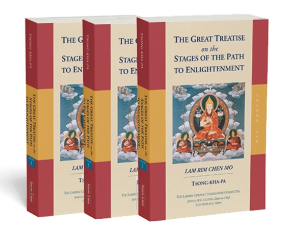
Emptiness is perhaps the most important—yet difficult to define—topic in Buddhism. Guy Newland, author of Introduction to Emptiness—a kind of every-person’s guide to the intricacies of various explanations of emptiness—based his book on The Great Treatise on the Stages of the Path: The Lamrim Chenmo by Tsong-kha-pa, of which he was the editor. Here he talks about really understanding emptiness, and why it’s important.
Christine Cox: You’re known for being able to convey the complexities about what emptiness is—and isn’t—in fresh ways that most people can understand. Have you had students who hear about emptiness, get a taste of it, and freak out? As in Omigod, what happened to my world?
Guy Newland: I do hear stories about people who, when they hear about emptiness, their hair stands up and they begin to cry. They feel that they’ve come home. My students haven’t reacted that dramatically, but some get very excited because the ideas about emptiness express something that they somehow always knew about the world but didn’t have a way to say. That makes sense to me [laughs]. We’re full all the time with all the information we need to refute our wrong views. We walk around as a bundle of contradictions, in a certain sense. It’s not surprising that some people would say Oh yes, this finally helps me make sense of the confusion I’ve had about how things are.
CC: On the other hand, perhaps there are people for whom emptiness teachings may not be currently helpful.
GN: People who are having psychological problems already of one sort or another, whether it’s issues with their own sense of identity or difficulties feeling any sense of boundaries between themselves and the world, probably should not be spending a lot of time thinking about emptiness.
CC: In your book you use an ingenious array of examples—from burning one’s mouth on pizza to dueling attorneys (to explain how Bhavaviveka and Chandrakirti’s views differ!)—to demonstrate quite subtle points about emptiness.
GN: Using things that are part of people’s common experience works well. For example, students can recognize that when they’re filled with desire, the object of their desire seems to be intrinsically or naturally appealing. As soon as you can see that, you’re on to identifying the object of negation. It really helps to get a sense that distorted ways of seeing things as having their own intrinsic nature is how we ordinarily look at the world. And that comes to the fore when we have strong afflictions present.
CC: This is probably an unfair question, but how would you encapsulate the various views on emptiness in Buddhism?
GN: Well, some traditions focus on the idea that emptiness is the absolute reality, the fundamental thing that exists, and that other things that appear are illusions. The practices involve allowing the fundamental purity that is the nature of things to shine out. I think that’s a common way to practice in Tibetan Buddhism; you can find parallels to it in other Mahayana traditions outside of Tibet as well.
And then there is another way of looking at things. It doesn’t disagree with that, exactly, but it shifts the focus a little and says, well, nothing absolutely exists. Nothing, including emptiness, exists in and of itself. Everything exists only conventionally because everything exists only interdependently. This is fundamentally true of even emptiness itself. That’s what Nagarjuna said; that’s what he meant when he said not to take dogmatic views of emptiness. He meant not to reify emptiness as an absolute essence. Therefore, in this view, emptiness is another conventionally existing thing. All things exist conventionally. Emptiness is the name that we give to one particular existing thing: the fact that nothing exists ultimately. And that’s a very different way of talking about things.
 This latter way of talking about things predominates in Nagarjuna’s Fundamental Treatise and in Chandrakirti and in Tsong-Kha-pa’s Great Treatise. These texts are not opposed to the idea of saying that emptiness is the fundamental reality. They do believe that emptiness is the final nature of things. But they want to avoid having that be understood as an absolute essence.
This latter way of talking about things predominates in Nagarjuna’s Fundamental Treatise and in Chandrakirti and in Tsong-Kha-pa’s Great Treatise. These texts are not opposed to the idea of saying that emptiness is the fundamental reality. They do believe that emptiness is the final nature of things. But they want to avoid having that be understood as an absolute essence.
I could probably boil it down: Do you think of emptiness as a kind of absolute essence of pure mind? Or do you think of it as the lack or absence of any essence? Anywhere? At all? Which way do you want to approach this? They’re really different, I think. Both of these views have scriptural basis in the Mahayana. Both of them have strong practice lineages in Tibet. I think HH the Dalai Lama has made a large effort in some of his teachings, such as in Kindness, Clarity, and Insight, to try to bridge these and show that they are both legitimate aspects of the Mahayana tradition and that people should see that these are both medicines that are in the Buddhist pharmacy, not distortions of the dharma.
CC: Understanding emptiness—not only conceptually but also experientially—seems to be a prerequisite for many Buddhist practices, certainly for tantra. How deep a realization of emptiness is needed before one begins the tantric path?
GN: It seems to me if you’re getting into self-generation as a deity, that should be done on a foundation of understanding emptiness, or you open yourself to danger in the practice when you’re visualizing yourself as a divine being. You have to understand that it’s an empty divine being—it’s a problem if you don’t, right? Good teachers understand that, but what they choose to do with it in terms of how they actually teach their students could be different.
For example, Lama Yeshe would say that it’s not expected that all students will have already realized emptiness as they start to do visualizations. So he would suggest that they think of space as a way to imagine emptiness. This recommendation has a scriptural basis—it says in one of the Perfection of Wisdom sutras that space is the best example people can use to think about what emptiness is like.
CC: In Great Treatise, on which your book is based, Tsong-kha-pa puts forward the idea that conceptual thought is not the root cause of our problems, but rather a tool for liberation.
GN: Of course that’s an absolutely core idea in the book. People sometimes have the idea that if they would simply stop thinking about things—sort of bury their heads in the sand—that problems would go away. They think that all that’s needed is to practice a deep kind of concentration—very, very focused and one-pointed. It could be a very peaceful state of mind that relieves us of all our ordinary troubles.
The wish to do this is deeply in us—kids will go on a merry-go-round until they’re dizzy just to stop their ordinary experience, or roll down a hill—which is what I did as a kid. Something within just wants a break from the constant talking in our heads—which can lead to sex or drugs or drumming, for example. The problem, of course, is that it doesn’t get at the root of our problems. If we don’t strengthen our thinking and analyze more carefully, then we don’t get at what’s really causing our suffering. Then as soon as the non-conceptual vacation is over, we come back to the same problems that we had before. They haven’t changed at all.
If the suffering world is only a thought-construction, then stopping thought does seem to be the most liberating move. Yet as Tsong-kha-pa famously argues, another step beyond this, seeing that not thinking is not enough, is at the very heart of what it means to be a Buddhist. Other religions have profound ethics, and techniques for accessing amazing non-conceptual states, but Buddhism claims the distinction of a penetrating analysis of how the world exists. Only by engaging this analysis, and engaging it conceptually, does one create the basis for real liberation from unnecessary misery. As Ch’an master Sheng Yen teaches, practice is not about stopping thought, for if it were, your teacher could just whack you in the head with a hammer.
CC: It sometimes feels that way…
GN: Yes! Once you have this understanding of how things exist, developed through careful analysis, you use the power of mental focus, developed in concentration and meditation, and make this understanding of emptiness the focus of your practice. That way you combine these two kinds of Buddhist meditation—the kind that involves focusing your mind and making it a powerful instrument, and the analytical power, discriminating and discerning and working out exactly how things exist. This is the path of preparation, preparing yourself to go into nirvana.
CC: Our editor described your book as being as close to a page-turner as a book on emptiness can get. I imagine you must have metabolized the various viewpoints on emptiness through yourself in order to present them so clearly.
GN: First of all, I was the main editor of Volume Three of the Great Treatise. It was a big challenge. That part of the book wasn’t written as an introduction; it was written for other scholars within the tradition to make it clear exactly what distinctions Tsong-kha-pa had sorted out and exactly how they were based in the Indian shastras. As a translator I had to understand it; one can’t just put the words into English without knowing what he’s saying. What I tried to do in Introduction to Emptiness is explain the ideas as I would to students—whether at universities or dharma centers. I had to say to myself, hey, what’s Tsong-khapa’s real point here and how can I express it in a way my readers will understand?
Books by Guy Newland

 One cannot become a Buddha without both compassionate action and nondual wisdom—and one cannot have these two types of paths without both of the two truths, conventional and ultimate. If only emptiness existed and there were, in fact, no conventional truths, then there would be no living beings, no suffering to relieve; thus there would be no compassionate action; and thus there would be no buddhahood. Therefore, maintaining the compatibility of the two truths—the compatibility of emptiness and dependent arising—is crucial to the whole of the Dharma.
One cannot become a Buddha without both compassionate action and nondual wisdom—and one cannot have these two types of paths without both of the two truths, conventional and ultimate. If only emptiness existed and there were, in fact, no conventional truths, then there would be no living beings, no suffering to relieve; thus there would be no compassionate action; and thus there would be no buddhahood. Therefore, maintaining the compatibility of the two truths—the compatibility of emptiness and dependent arising—is crucial to the whole of the Dharma.
Tsong-kha-pa explains that when we understand the compatibility of dependent arising and emptiness, we see that nihilistic misreadings of Madhyamaka in fact have much in common with the eternalist extremes of those who cling to the idea of intrinsic nature. To understand this, consider that the basic question—the compatibility of emptiness and dependent arising—can be posed as follows: Can A produce B when A is empty? If A is devoid of intrinsic nature, how can it produce B? Suppose that A, the cause, is a seed and B, the effect, is a sprout. Now let’s consider three answers to these questions: (1) the answer of the essentialists (including many Buddhists), (2) the answer of those who, in interpreting Madhyamaka, negate too much, and (3) the answer of Tsong-kha-pa.
Essentialists: A seed cannot produce a sprout if the seed is empty of intrinsic nature. If the seed does not have, in its intrinsic nature, the capacity to produce a sprout, then a sprout will not be produced from the seed. Since sprouts are produced, we know that their causes, seeds, must have in their essential nature the power to produce sprouts.
Those who negate too much: We agree that a seed cannot produce a sprout when the seed is empty of intrinsic nature. If the seed does not have, in its intrinsic nature, the capacity to produce a sprout, then a sprout will not be produced from the seed. However, Madhyamaka analysis shows that seeds have no intrinsic nature; thus, it follows that sprouts are not produced. All production, all existence, is a delusion.
Tsong kha pa: A seed can produce a sprout when the seed is empty of intrinsic nature, as is frequently observed in the world. A seed does not need an intrinsic nature in order to produce a sprout. In fact, it is only because seeds lack intrinsic nature that dependent arising can take place as observed.
From Introduction to Emptiness: As Taught in Tsong-kha-pa’s Great Treatise on the Stages of the Path by Guy Newland
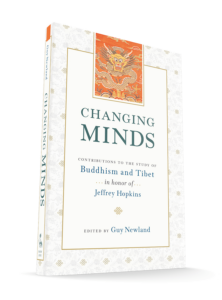
| The following article is from the Spring, 2001 issue of the Snow Lion Newsletter and is for historical reference only. You can see this in context of the original newsletter here. |
Contributions to the Study of Buddhism and Tibet In Honor of Jeffrey Hopkins
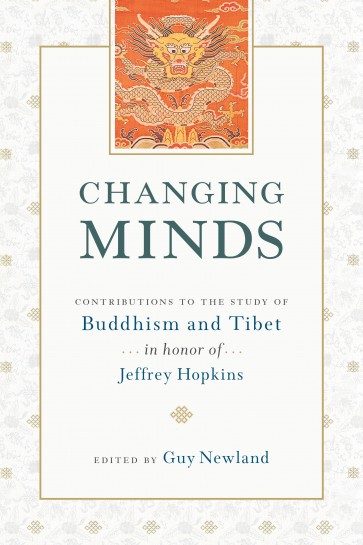
This is a book offered in tribute to Jeffrey Hopkins by colleagues and former students. Jeffrey Hopkins has, in his sixty years, made profound and diverse contributions to the understanding of Tibet and Tibetan Buddhism in the West. In his collaborations with the Dalai Lama, such as Kindness, Clarity, and Insight, and in books like Tibetan Arts of Love and Emptiness Yoga, Hopkins has reached out to the general reader, making the wisdom of Tibet accessible to every one. Yet there is never anything superficial about his work; his recent Emptiness in the Mind-Only School is a magisterial display of painstaking scholarly work.
Changing Minds contains essays that reflect the breadth and influence of Hopkins.
The following is an excerpt from the Editor's Introduction.
Twenty-five years ago I first met Jeffrey Hopkins as my instructor in a popular undergraduate course on Buddhist meditation at the University of Virginia. 1 liked the course and studied with him for almost thirteen yearsbecause of the way Hopkins presented Buddhist ideas. He did not posture as the authoritative curator of a mummified body of knowledge. He did not mystify the tradition and he certainly did not act as a missionary for it. On the other hand, he did not attempt to account for Buddhism in terms of any extrinsic academic ideology. Instead, Hopkins was interested in encountering Buddhist worldviews as living systems of human meaning; his classes were invitations to participate in that encoimter. They were based on his own meticulous translations of primary-source Tibetan or Sanskrit texts, sometimes produced in collaboration with Tibetan colleagues. The message that I got, from his teaching and his books, was: There are and long have been real people, whole communities and civilizations, for whom the ideas and texts we are now studying are profoundly important. We should show them the respect of taking their ideas seriously. That means finding out how far we can go in understanding how others make sense of the worldand seeing how our minds change in the process.
Hopkins presented Tibetan Buddhism as a living system of meaning in part by bringing to campus distinguished Tibetan scholars from the refugee communities of India. At that time, in the middle of the 1970s, this was something quite rare; most of my fellow undergraduates had heard the term Dalai Lama only as a Johnny Carson punch-line. Sometimes a monk would accompany Hopkins to class and speak to us in Tibetan, with Hopkins translating. Hopkins taught many undergraduate and graduate courses in this way while I was at the University of Virginia. There is no doubt that the presence of visiting Tibetan scholars on campus greatly enriched my education in the graduate Buddhist Studies program. Instead of having only Hopkins representing and mediating Tibetan Buddhism to us, we had continuing opportunities to work with scholars whose credentials to speak from within and on behalf of the tradition were unimpeachable. Some graduate students in the program likely developed, outside of class, spiritual connections with these lamas that were deeper and more important to them than their academic relationship with Hopkins.
That was not my experience; I was not drawn into the program mainly by the Tibetan scholars. After all, they could not speak English and only Hopkins and the more advanced graduate students could really question them directly. For me, the heart of the program was Hopkins. He had no superficial flash as a public speaker, but he had intellectual substance and passion. He conveyed his prodigious learning with an intensity that John Buescher conjures from the past in the opening article of this volume. Buescher gives us Hopkins at workguiding students through the complexities of Sanskrit syntax, teaching them how to pull from the tangle something that would change their minds:
It's the self of persons and of things
that we're looking for, Jeffrey said, as he pointed to Nagarj una's text in front of him. The tiling that seems to cover over them and make them a whole, single entity, assembling things out of their parts. We've got to take them apart to see it. Parsing the words of the text, then translating them, the operation became unexpectedly exacting. Sweat rolled down in tight, little streams under my shirt. We were unprepared for this drill, this scalpel. Jeffrey, however, proceeded on, laying bare our ignorance, peremptorily rejecting any uncertain or wrong answer. As he thundered his demand for the right answer, we searched for it. We desperately wished we could find it, some seat of the soul, some little treasure amid the remains of the words that now lay in pieces all about us.
Did these teaching methods leave room for students to challenge the tradition itself, to form their own critical evaluation of it? In my undergraduate courses with Hopkins, he seemed to regard it as satisfactory if a student could think through some of the complexities of Tibetan Buddhist doctrine. He certainly did not forbid etic analysis or independent critique, but he did little to encourage it. This might not seem ideal, but it did not strike me as so different from many other courses that I had taken, in Russian literature, Greek tragedy, or experimental psychology, for example. In each case, the premise was that there is a very complicated, very unfamiliar story to be told. The novice must expect to spend time on the ground of the storyteller, learning the story well and getting the details straight, before launching an idiosyncratic metanar- rative on what the story (in this case someone else's religion) is really about.
As a graduate student, my experience was that Hopkins wanted even demandedwork that was not only intimately grounded in the details of the tradition, but also had something to say, something useful or insightful. As I gained mastery of a research topic (and not before), he clearly expected more of me than a re-transmission of what learned lamas had said. For example, he told me that my seminar paper on the Abhisamayalamkara was boring because it simply reorganized information from the tradition. On another occasion, Hopkins asked me to present a paper in an interdepartmental colloquium series, assigning me a topic from the work of the Sa skya scholar sTag tshang. I decided on my own that I would instead give a psychoanalytic treatment of Tsong kha pa on the three principal aspects of the path. When he heard my talk, rather than being upset that I had presumed to offer an independent analysis, he was clearly pleased. The same was true when I submitted my dissertation; when I used various Western theories to give an independent account of the religiosity of dGe lugs scholasticism, Hopkins's criticisms were aimed only at strengthening my argument.
Hopkins's scholarship likewise evidences concern to avoid arrogant pseudo-objectivity on the one hand and naive adulation on the other. Hopkins has taken special pains to avoid the first of these extremes and has been more careful in that regard than some. By being open in his appreciation for some aspects of the traditions he studies, Hopkins has at times chosen to risk appearing to some as an academic front-man for religious dogma. In books such as Meditation on Emptiness and The Tantric Distinction, Buddhist thought-systems are not specimens to be dissected at arm's length. Instead, Hopkins recreates his encounter with another world of meaning, a very particular and intricate Asian Buddhist world which can never again be imagined as completely separate from our world. Describing his version of a methodological middle way, Hopkins writes that his aim is to evince a respect for the directions, goals, and horizons of the culture itself without swallowing an Asian tradition as if it had all the answers or...pretending to have a privileged position.
* * *
Don Lopez and Joe Wilson conceived that this book should come into being to honor Jeffrey Hopkins in his sixtieth year. At their suggestion and with the encouragement of Anne Klein, I undertook the project, soliciting contributions only from a close circle of Hopkins's friends, admirers, and former students. Then, with some assistance from Snow Lion and outside readers, I selected the articles in this volume for publication. As Paul Hackett shows in the closing article of this volume, Hopkins's research has covered a wide range of concerns, centering on dGe lugs scholarship but ranging far beyond it in several directions. A thin cross-section of that diversity is reflected in the scholarship here.

Describing his version I of a methodological middle way, Hopkins writes that his aim is to evince a respect for the directions, goals, and horizons of the culture itself without t swallowing an Asian tradition as if it had all the answers or... pretending to have a privileged position.
John Buescher opens our volume with an atmospheric and evocative real-life detective story. Caught in the act of teaching Madhyamika Buddhism, Hopkins appears as a philosophical sleuth on the trail of truth. Buescher then weaves into this portrait its unexpected resonances, years later, in a baffling international news-eventthe sudden appearance of a previously unknown dental relic of the Buddha.
The Madhyamika theme continues through the next two articles, by Guy Newland and Donald Lopez. My article is inspired in part by the efforts of Hopkins to describe the Madhyamika view for a general readership. I summarize some of the philosophical claims Tsong kha makes in Lam rim chen mo, reflecting in particular on the notion of conventional reality. Lopez's piece distills a careful synopsis of Tsong kha pa's treatment of the object of negation (dgag bya) in Madhyamika analysis. Then, based on his own new translations, he treats us to a riveting critique of this position by the brilliant twentieth-century iconoclast, dGe dun Chos phel.
Contributions by Dan Cozort and Elizabeth Napper keep the focus on Tsong kha pa and his Lam rim chen mo, but move away from Madhyamika Cozort provides a useful, clear, and detailed analysis of Tsong kha pa on the special dangers of anger, which is said to cut the roots of virtue. What, exactly, does this mean? How deep is the damage of anger? Cozort finds Tsong kha pa working with mixed success to explicate this doctrine and integrate it into his system. Like Cozort, Napper scrutinizes Lam rim chen mo in her contribution, Ethics as the Basis of a Tantric Tradition: Tsong kha pa and the Founding of the dGe lugs Order in Tibet. She lays out exactly how Tsong kha pa used his sources, subtly and skillfully reshaping grammar, nuance, and context in order to build a new and unique system of religious meaning. She concludes with some frank observations about the impact that the distinctive features of this system (such as its emphasis on monastic ethics) have had on the later tradition. Nap- per's impeccable work, synthesizing insights from many years of work with Lam rim chen mo and its sources, merits the appreciation of everyone who studies the dGe lugs order.
The next pair of articles shift our attention to the contemplative traditions of rDzogs chen and Mahamudra. Anne Klein takes us into the realm of Bon rDzogs chen poetry. Her original translations gracefully depict a natural, open awarenessunrecognized by ordinary personsin which reality is experienced as spontaneous and unbounded wholeness. She carefully explains who reads such poetry, to what end, and she compares the handling of contradiction and nonduality in Buddhist Madhyamika with that in Bon rDzogs chen. Roger Jackson then gives us an outstanding treatment of a little- known topic, the tradition of dGe lugs Mahamudra (phyag rgya chen po). As he notes, Mahamudra is more usually associated with meditative practices central to the bKa' brgyud tradition of Tibetan Buddhism. Questions about the role of and basis for a dGe lugs form of Mahamudra lead Jackson to broader insights about inter-sectarian connections.
As Hopkins suggests, our understanding of early dGe lugs has been much aided by recent advances in our grasp on the teachings of Shes rab rgyal mtshan and the Jo nang other emptiness doctrine. Here we offer two articles which touch on this issue, demonstrating how the self-empty vs. other-empty controversy set the stage for otherwise disparate debates. Displaying his formidable knowledge of Tibetan Perfection of Wisdom literature, Gareth Sparham shows how debates about the authorship and authority of key commentaries evolved within the context of controversy between dGe lugs and Jo nang views. Then, Joe Wilson gives us a generous and cogent explication of how and why the concept of a basis-of-all (alay- avijnana, kun gzhi rnam par shes pa) is subject to radically different constructions in the Jo nang and dGe lugs traditions.
While cross-cultural and comparative themes are touched upon in other contributions, Jose Cabezon and Harvey Aronson bring them into focus. Cabezon analyzes the structure and content of Tibetan colophons, looking for evidence of an implicit theory of authorship and literary production. Simplistic notions of authorship are quickly problema- tized by the multiple layers of productivity through which a book is generated. Cabezon has given us a unique and nuanced study, full of allusions to and connections with the conversations of Western literary theory. Such cross-cultural comparison arises from historical contact; in the case of Tibetan Buddhism, that contact includes the unprecedented phenomenon of large numbers of Westerners taking up Buddhist practices and striving to embody Buddhist virtues. Using object-relations theory and his own experience as a clinician, Harvey Aronson warns of the pathological pitfalls that may afflict the self-sacrificing American bodhisattva, but argues for a model of healthy altruism.
Our volume concludes with Paul Hackett's comprehensive survey of the published works of Jeffrey Hopkins. We are grateful to Hackett for an ambitious essay charting the range and depth of Hopkins's oeuvre. Inasmuch as Hopkins's recently published Emptiness in the Mind-Only School has been hailed by many as his best work ever, and inasmuch as it is the first of a tliree-volume series, Hackett's work will perhaps but serve as a starting point for future bibliographic analysis.
In sum, this volume is presented as a tribute to the work of Jeffrey Hopkins as a teacher and as a scholar. Paul Hackett has written eloquently of Hopkins's impact:
Most people who have pursued knowledge and learning would be hard pressed not to remember at least one teacher sometime, somewhere, who first inspired them and instilled in them a sense of value in learning. This ability, the capacity not only to convey meaning, but also to motivate remains an art which stands apart from mere erudition. For some, it comes naturally; for others it requires effort; though in each person who manages to master it, there is always evident an idiosyncratic artistry by which their knowledge and experience is conveyed. So it is with Jeffrey Hopkins, who has repeatedly demonstrated not only his depth of knowledge, but also his skill as a teacher and writer.
As we see in this volume, he has inspired and enlivened us in many different ways. So now we say: Thank you!


